- The SARS-CoV-2 coronavirus: a primer
- Introduction
- Profile of a killer
- Origins of the coronavirus
- Coronavirus basics
- Coronavirus infection
- Coronavirus life cycle
- Respiratory tract infection
- The Coronavirus spike
- Genes express proteins
- The protective viral structural proteins
- The viral accessory proteins
- Glycans, the sugar shield
- The coronavirus spikes invade cells
- How the coronavirus infects cells
- Barbed and ready
- Restricted entry
- Deadly competition
- How a rampant coronavirus variant blunts our immune defenses
- Syncytia
- A final cut
- Mutants/variants of the coronavirus spike
- Evolution/mutation of the coronavirus spike
- The omicron variant
- The omicron variant structure
- The omicron subvariant BA.5 surge
- Escaping the immune system
- evolving coronavirus uses mimicry
- measuring virus transmissibility
- mechanisms of increased transmissibility
- After BA.5…
The SARS-CoV-2 coronavirus: a primer
Last updated: September 3, 2022. To go directly to the last updated section click on the link.
Introduction
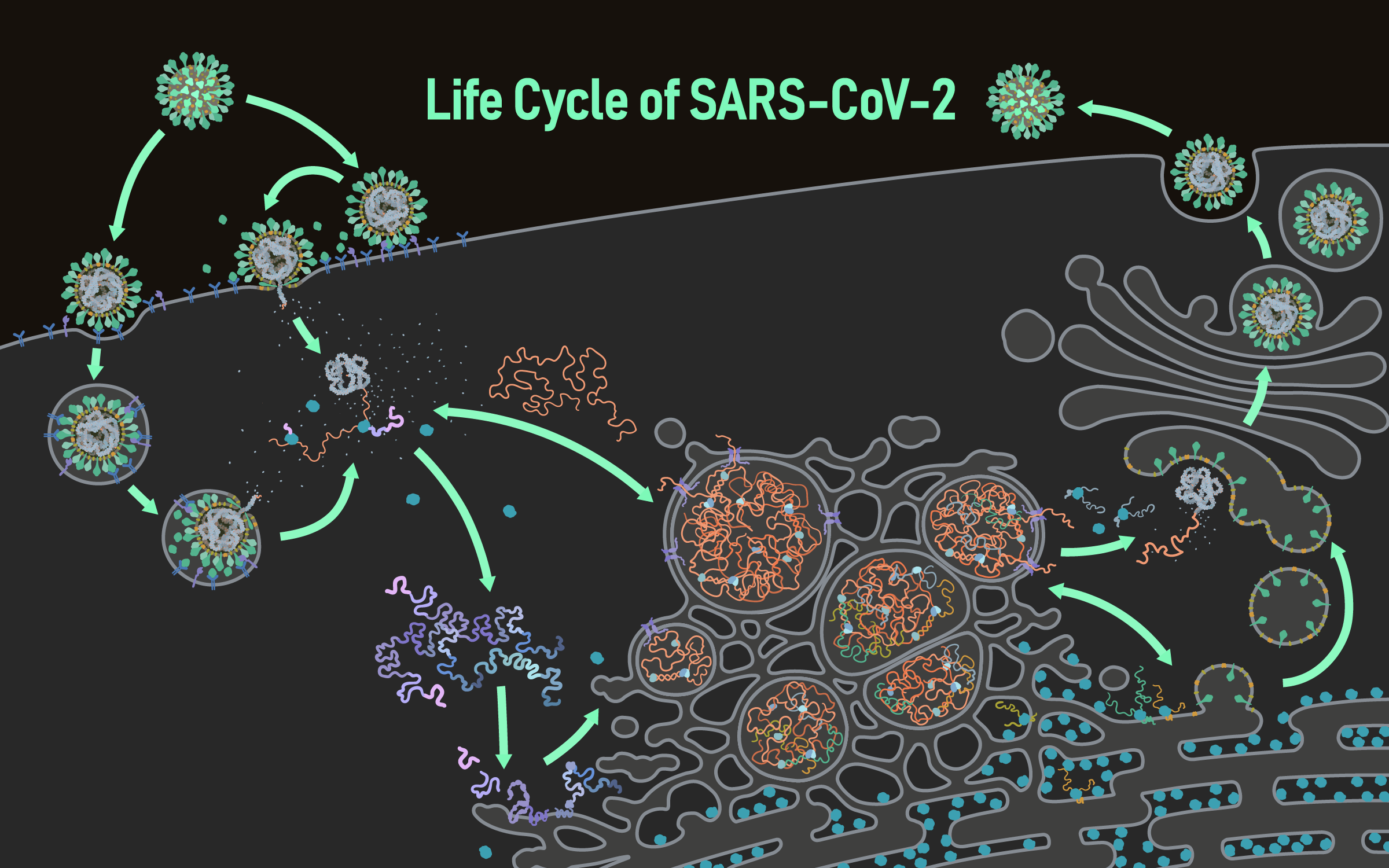
Life cycle of SARS-CoV-2 coronavirus
Thought initially to be primarily a respiratory virus, the SARS-CoV-2 coronavirus can also infect cells in the heart, the kidneys, the brain, and the gut which may explain why COVID-19 exhibits so many different symptoms.
Profile of a killer
In 1912, German veterinarians puzzled over the case of a feverish cat with an enormously swollen belly. That is now thought to be the first reported example of the debilitating power of a coronavirus. Veterinarians didn’t know it at the time, but coronaviruses were also giving chickens bronchitis, and pigs an intestinal disease that killed almost every piglet under two weeks old.
The link between these pathogens remained hidden until the 1960s when researchers in the United Kingdom and the United States isolated two viruses with crown-like structures causing common colds in humans. Scientists soon noticed that the viruses identified in sick animals had the same bristly structure, studded with spiky protein protrusions. Under electron microscopes, these viruses resembled the solar corona, which led researchers in 1968 to coin the term coronaviruses for the entire group.
Researchers thought that coronaviruses caused only mild symptoms in humans, until the outbreak of severe acute respiratory syndrome (SARS) in 2003 revealed how easily these versatile viruses could kill people.
The SARS-CoV-2 coronavirus has evolved an array of adaptations that make it much more lethal than the other coronaviruses humanity has met so far. It can readily attack human cells at multiple points, with the lungs and the throat being the main targets. Once inside the body, the virus makes use of a diverse arsenal of dangerous molecules.
Genetic evidence suggests that it has been hiding out in nature possibly for decades.
Origins of the coronavirus
Coronaviruses frequently recombine, swapping chunks of their RNA with other coronaviruses. When two distant coronavirus relatives end up in the same cell, recombination can lead to more virulent versions that infect new cell types and jump to other species.
Recombination happens often in bats, which carry 61 viruses known to infect humans; some species harbour as many as 121. In most cases, the viruses don’t harm the bats.
Estimates for the birth of the first coronavirus vary widely from 10,000 years ago to 300 million years ago. Scientists are now aware of dozens of strains, seven of which infect humans. Among the four that cause common colds, two (OC43 and HKU1) came from rodents, and the other two (229E and NL63) from bats. The three that cause severe disease — SARS-CoV (SARS), Middle East respiratory syndrome MERS-CoV, and SARS-CoV-2 — all came from bats. However, there is usually an intermediary — an animal infected by the bats that carries the virus into humans. With SARS, the intermediary is thought to be civet cats, which are sold in live-animal markets in China.
The SARS-CoV-2 coronavirus shares 96% of its genetic material with a virus found in a bat in a cave in Yunnan, China — but there’s a crucial difference. The spike proteins of coronaviruses have a unit called a receptor-binding domain, which is central to their success in entering human cells. The SARS-CoV-2 binding domain is particularly efficient, and it differs in important ways from that of the Yunnan bat virus, which seems not to infect people.
Source: M. F. Boni et al. Preprint at bioRxiv https://doi.org/10.1101/2020.03.30.015008 (2020).
Complicating matters, a scaly anteater called the pangolin showed up with a coronavirus that had a receptor-binding domain almost identical to the human version, cut the rest of the coronavirus was only 90% genetically similar. The fact that both mutations and recombinations are at work complicates efforts to draw a family tree for the SARS-CoV-2 coronavirus.
But studies released over the past few months, shows evidence that the coronavirus lineage leading to SARS-CoV-2 split more than 140 years ago from the closely related one seen today in pangolins. Then, sometime in the past 40–70 years, the ancestors of SARS-CoV-2 separated from the bat version, which subsequently lost the effective receptor binding domain that was present in its ancestors and remains in SARS-CoV-2.
These results suggest a long family history, with many coronavirus branches in bats and possibly pangolins carrying the same deadly receptor binding domain as SARS-CoV-2, including some that might have similar abilities to cause a pandemic.
Coronavirus basics
At 125 nanometres in diameter, coronaviruses are relatively large for the viruses that use RNA to replicate, the group that accounts for most newly emerging diseases. With 30,000 bases, coronaviruses have the largest genomes of all RNA viruses. Their genomes are more than three times larger than HIV and hepatitis C, and more than twice influenza’s.Coronaviruses are also one of the few RNA viruses with a genomic proofreading mechanism which keeps the virus from accumulating mutations that could weaken it.
There are hundreds of coronaviruses, most of which circulate among animals such as pigs, camels, bats and cats. Sometimes those viruses jump to humans—called a spillover event—and can cause disease. Four of the seven known coronaviruses that sicken people cause only mild to moderate disease. Three can cause more serious, even fatal, disease.
SARS coronavirus (SARS-CoV) emerged in November 2002 and caused severe acute respiratory syndrome (SARS). That virus disappeared by 2004.
Middle East respiratory syndrome (MERS) is caused by the MERS coronavirus (MERS-CoV) transmitted from an animal reservoir in camels. MERS was identified in September 2012 and continues to cause sporadic and localized outbreaks.
The third novel coronavirus to emerge in this century is called SARS-CoV-2. It causes coronavirus disease 2019 (COVID-19), which emerged from China in December 2019 and was declared a global pandemic by the World Health Organization on March 11, 2020.
Coronavirus infection
The following is an over-simplified schematic diagram of some of the invasive adaptations utilized by the SARS-CoV-2 coronavirus to attack human cells.
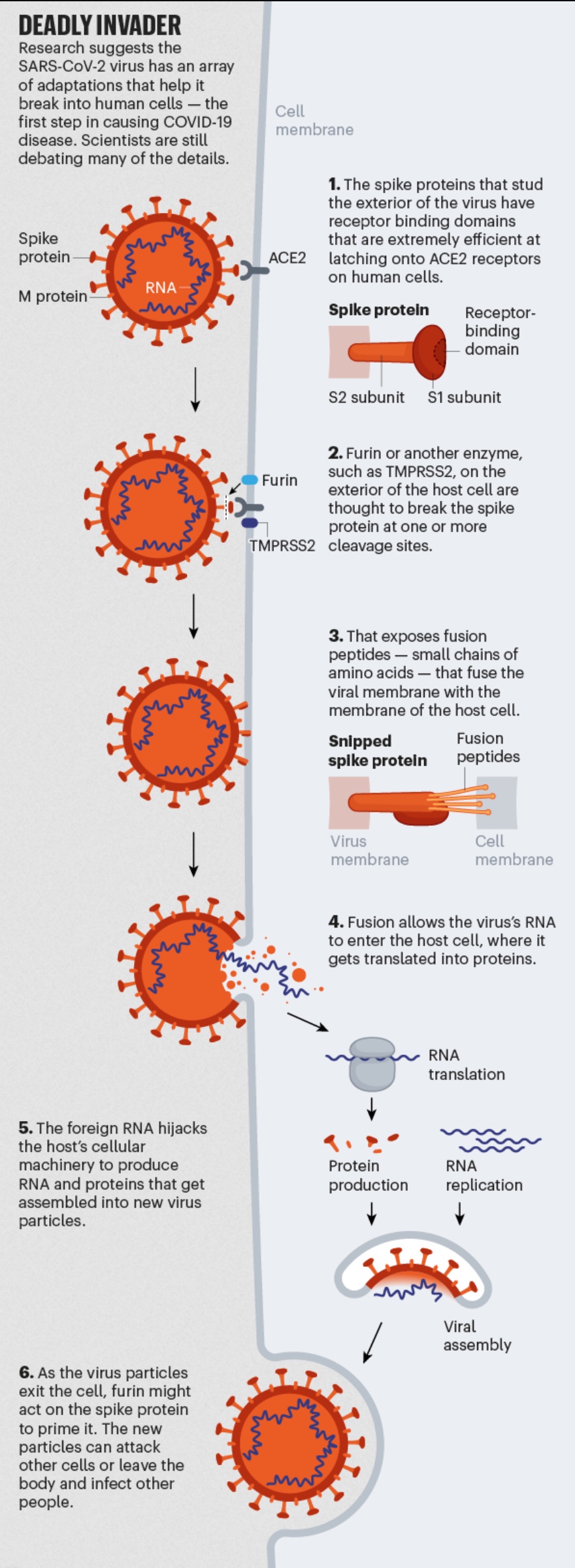
Deadly invader_2021
SARS-CoV-2 coronavirus life cycle

SARS-CoV2 coronavirus life cycle
Some of the following material was adapted from 2021 Nikon, Small World in Motion Competition
A video shows the view through a microscope of “SARS-CoV-2 infection triggering cell fusion and cell death (red) in bat (Myotis myotis) brain cells.
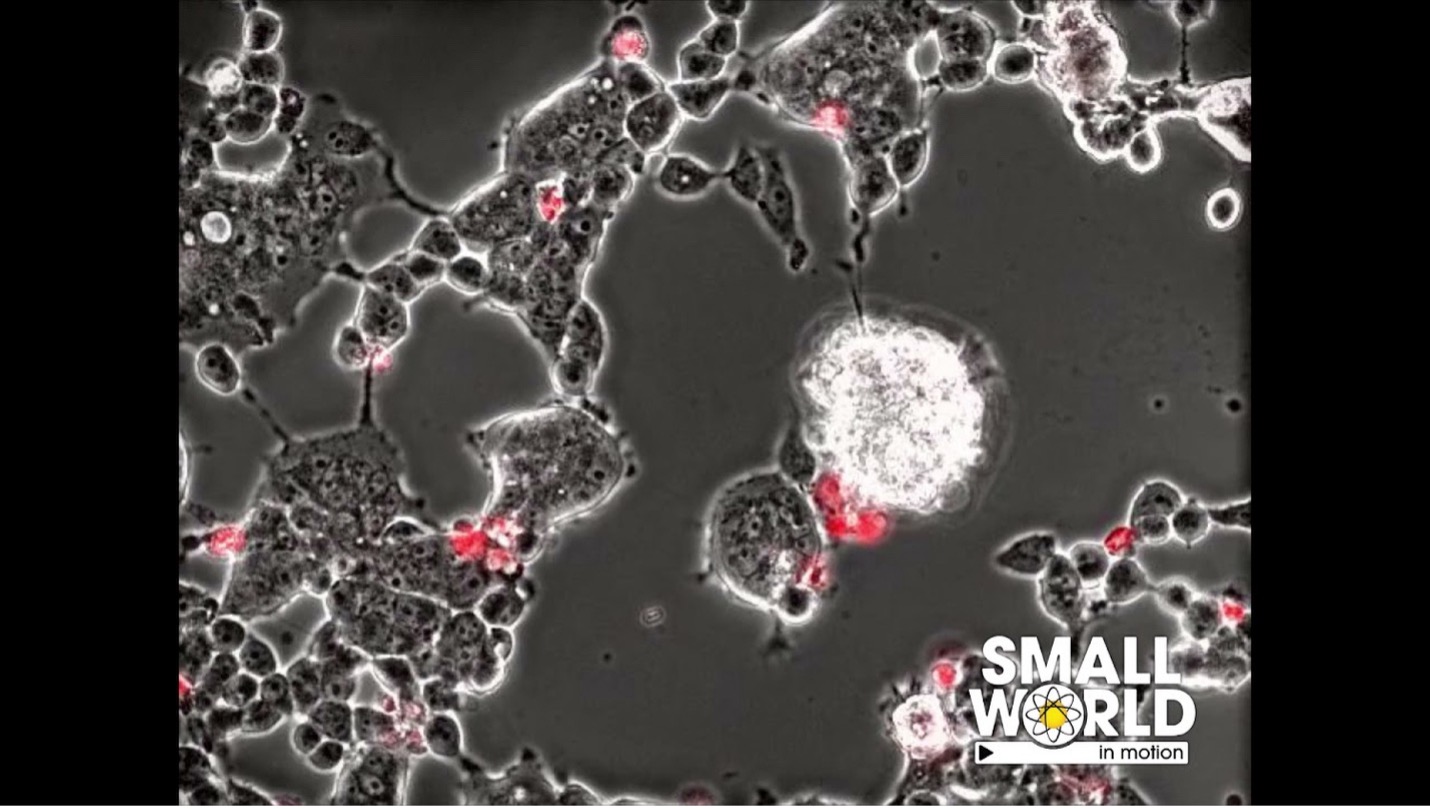
SARS-CoV-2 infection
Video by Sophie-Marie Aicher & Dr. Delphine Planas, virologists at the Pasteur Institute in Paris.
Honorable mention in the 2021 Nikon Small World in Motion Competition.
This video was filmed over a 48-hour period with an image captured every 10 minutes. To capture the video, the virologists employed fluoresence imaging, which uses high intensity light to stimulate fluorescent molecules in the sample. They also used phase contrast microscopy, which is “an optical technique that exploits changes in refractive index to produce high-contrast images of transparent specimens.
The coronavirus infecting bats differs from how the virus attacks human cells in only one significant way: the bats don’t get sick.
In humans, the coronavirus is able to evade detection and cause more damage in part by preventing infected cells from alerting the immune system to the presence of the invaders. But its special power is the ability to force host cells to fuse with neighboring ones, a process known as syncytia that allows the coronavirus to remain undetected as it replicates.
The coronavirus is depicted as the red spots in the clip which surround and then infiltrate the bat’s brain cells, which are the gray, blobby areas. After they are infected, the infected cells begin to fuse with neighboring cells until the entire mass bursts resulting in the death of the cells.”
The video was filmed the footage shows an array of bat brain cells, which appear as gray blobs, interspersed with red dots, which are the cells dying after having been infected with the virus. The infected cells fuse with neighboring ones to form larger masses, and toward the end of the video, they explode, signaling their demise.
Respiratory tract infection
Although the known human coronaviruses can infect many cell types, they all mainly cause respiratory infections. The four that cause common colds easily attack the upper respiratory tract, whereas MERS-CoV and SARS-CoV have more difficulty gaining a hold there, but are more successful at infecting cells in the lungs. SARS-CoV-2, unfortunately, can do both very efficiently. That gives it two places to get a foothold.
The virus can start in the throat or nose, producing a cough and disrupting taste and smell, and then end there. Or it might work its way down to the lungs and debilitate that organ. How it gets down there, whether it moves cell by cell or somehow gets washed down, is not known.
Having these two infection points means that SARS-CoV-2 can mix the transmissibility of the common cold coronaviruses with the lethality of MERS-CoV and SARS-CoV.
The virus’s ability to infect and actively reproduce in the upper respiratory tract was something of a surprise, given that its close genetic relative, SARS-CoV, lacks that ability. SARS-CoV-2 can shed viral particles from the throat into saliva even before symptoms start, and these can then pass easily from person to person. SARS-CoV was much less effective at making that jump, passing only when symptoms were full-blown, making it easier to contain.
What SARS-CoV-2 does when it gets down to the lungs is similar in some respects to SARS-CoV and influenza; it infects and destroys the alveoli, the tiny sacs in the lungs that shuttle oxygen into the bloodstream. As the cellular barrier dividing these sacs from blood vessels break down, liquid from the vessels leaks in, blocking oxygen from getting to the blood. Other cells, including white blood cells, plug up the airway further.
A robust immune response will clear all this out in some patients, but overreaction of the immune system can make the tissue damage worse. If the inflammation and tissue damage are too severe, the lungs never recover and the person dies or is left with scarred lungs.
A SARS-CoV-2 infection can trigger an excessive immune response, a cytokine storm, which can lead to multiple organ failure and death. The virus can also infect the intestines, the heart, the blood, sperm (as can MERS-CoV), the eye and possibly the brain. Damage to the kidney, liver and spleen observed in people with COVID-19 suggests that the virus can be carried in the blood and infect various organs or tissues.
Whether it infects the throat or the lungs, SARS-Cov-2 breaches the protective membrane of host cells using its spike proteins. First, the protein’s receptor-binding domain latches on to a receptor called ACE2, which sits on the surface of the host cell. ACE2 is expressed throughout the body on the lining of the arteries and veins that course through all organs, but it is particularly dense on the cells lining the alveoli and small intestines.
The Coronavirus “spike”
The SARS-CoV-2 virus is studded with proteins that it uses to enter human cells.
The vaccines now being distributed throughout the world to combat the SARS-CoV-2 coronavirus pandemic target the spike proteins on the surface of the virus particle and attempt to stimulate the natural immune system of each individual in the exposed population to produce specific antibodies to the virus.
 Cryo-electron tomography image of SARS-CoV-2 viruses, in gray, with a computer reconstruction of one virus.
Cryo-electron tomography image of SARS-CoV-2 viruses, in gray, with a computer reconstruction of one virus.
Sai Li, a structural biologist at Tsinghua University School of Life Sciences, Beijing https://www.nytimes.com/interactive/2020/health/coronavirus-unveiled.html? ”

coronavirus; spike RNA
A cryo-electron tomography image of SARS-CoV-2 viruses.
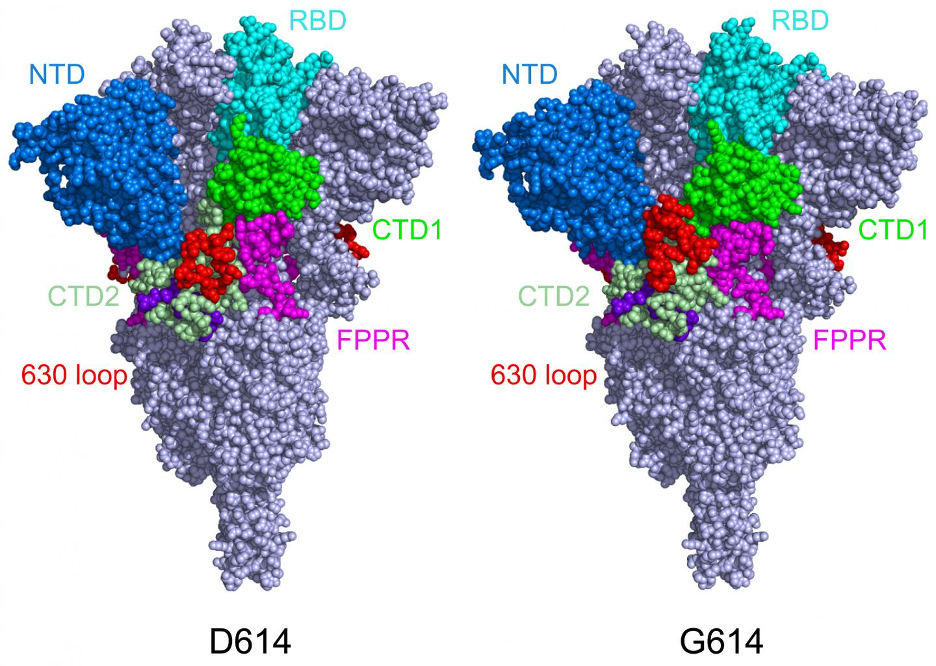
spike protein model (closed configuration)Bing Chen, PhD, Boston Children’s Hospital
Molecular dynamics (MD) simulations help pinpoint the molecular origins of the flexibility seen in the tomograms.

Fitting of molecular simulations into cryo–electron tomograms
(A) Slices through tomograms (left) and isosurface-rendered tomograms with snapshots of the respective MD simulations superimposed without flexible fitting (right). The hinges of the stalk domain predicted by structural modeling (orange arrowheads) are consistent with the tomographic data. Scale bar, 5 nm. Molecular Dynamics (MD) simulations of SARS-CoV-2 S protein
(A) Model of the S protein. The three individual chains of S are shown in shades of red, N-glycosylation in blue, lipids of the endoplasmic reticulum–like membrane in gray, and phosphates in green. “Hip,” “knee,” and “ankle” mark positions of the three flexible hinges. Analysis of S protein glycosylation sites and epitopes
(A) N-glycosylation sites are clearly discernible in the subtomogram average of the head. From left to right: Isosurface rendering of subtomogram average with an individual N-glycosylation site indicated (orange arrowhead); superimposed with the MD-calculated density for all annotated N-glycosylation sites; superimposed with previous structural model of the head (PDB ID 6VXX); and superimposed with a snapshot of the MD simulations. N-glycosylation sites are shown in blue.
(B) Fit of snapshots of MD simulations into the classes obtained for different distances of the head from the membrane (1 to 4). Shorter distances are concomitant with a stronger bending of the hinges and a lateral displacement of the stalk. Average MD density filtered to a resolution comparable to the subtomogram averages is shown as an isosurface rendering (right). Science 09 Oct 2020: Vol. 370, Issue 6513, pp. 203-208; DOI: 10.1126/science.abd5223

(B) Examples of the hinges as seen in the deconvoluted tomograms. Blue and orange arrowheads indicate the upper and lower legs, respectively, with their typical lengths indicated. Scale bar, 10 nm.
(C) Hinge flexibility in the MD simulation illustrated through backbone traces (gray) at 75-ns intervals with different parts of the S protein fixed (red).
(D) Probability density functions (pdf) for hinge bending angles at the hip, knee, and ankle. Science 09 Oct 2020: Vol. 370, Issue 6513, pp. 203-208; DOI: 10.1126/science.abd5223

(B) Tomographic slice highlighting an N-glycosylation site (orange arrowheads) in the original data. Scale bar, 5 nm.
(C) Highlight of N-glycosylation positions 709 and 1134 of the MD simulations (top) and in a previous structural model (bottom; PDB ID 6VXX, EMDB 21452). The subtomogram average is shown superimposed at different isosurface thresholds (transparent gray). Extensive additional density is visible. (D to F) The stalk domain is heavily glycosylated at the hinges.
(D) Example tomographic slices with bulky density at the hinge positions (orange arrowheads). Scale bar, 5 nm.
(E) Superposition of the subtomogram averages (transparent gray isosurfaces) of the head (framed red) and the stalk domain (framed green), with a respective snapshot of the MD simulations emphasizing the glycosylation at the hinges.
(F) Same as (E) but shown as a maximum intensity projection through the subtomogram averages. Orange arrowheads indicate bulky density at hinges.
(G) Fits of snapshots from MD simulations into the surface of a virion. The tomogram is shown isosurface rendered in transparent gray. The position of epitopes for neutralizing antibodies at the RBDs (receptor-binding domainsare indicated with blue arrowheads.
(H) Graphic illustration of a hypothetical docking event in which the hinges facilitate the engagement of multiple instances of S with their receptors. Science 09 Oct 2020: Vol. 370, Issue 6513, pp. 203-208; DOI: 10.1126/science.abd5223
Genes express proteins
The following section is adapted from material contained in a New York Times feature by Jonathan Corum and Carl Zimmer published on April 3, 2020 at https://www.nytimes.com/interactive/2020/04/03/science/coronavirus-genome-bad-news-wrapped-in-protein.html
In 1977, biologists Jean and Peter Medawar wrote,
A virus is “simply a piece of bad news wrapped up in protein,”
The genome of the SARS CoV-2 coronavirus is less than 30,000 “letters” long. The human genome is over 3 billion. Scientists have identified genes for as many as 29 proteins of the coronavirus, which carry out a range of jobs from making copies of the coronavirus to suppressing the body’s immune responses.
The first sequence of RNA letters recruits machinery inside the infected cell to read the RNA letters — a, c, g and u for the bases adenine, guanine, cytosine and uracil — and translate them into coronavirus proteins.

ORF1ab

NSP1

NSP2
NSP2 function is unknown but two of the other proteins it attaches to help move molecule-filled bubbles called endosomes around the cell.

NSP3
NSP3 is a large protein that cuts loose other viral proteins so they can do their own tasks. It also alters many of the infected cell’s proteins. Normally, a healthy cell tags old proteins for destruction. But the coronavirus can remove those tags, changing the balance of proteins and possibly reducing the cell’s ability to fight the virus.

NSP4
NSP4, combining with other proteins, helps build fluid-filled bubbles within infected cells. Inside these bubbles, parts for new copies of the virus are constructed.

NSP5
NSP5 makes most of the cuts that free other NSP proteins to carry out their own jobs.

NSP6
NSP6 works with NSP3 and NSP4 to make virus factory bubbles.

NSP7

NSP8
NSP7 and NSP8 help NSP12 make new copies of the RNA genome, which can ultimately end up inside new viruses

NSP9
NSP9 infiltrates tiny channels in the infected cell’s nucleus, which holds our own genome. It may be able to influence the movement of molecules in and out of the nucleus, but for what purpose, no one knows — yet.

NSP10
NSP 10 works with NSP16 to camouflage the virus’s genes so that they don’t get attacked by the host’s antiviral proteins that find viral RNA and shred it.

NSP12
NSP12 assembles genetic letters into new virus genomes. The antiviral remdesivir interferes with NSP12 in other coronaviruses, and successfully treat Covid-19. The infected cell begins reading the RNA sequence for NSP12, then it backtracks and reads it again.
Another sequence, NSP11, overlaps part of the same stretch of RNA, but the function of the tiny protein encoded by this gene is unknown.

NSP13
NSP13 may unwind virus RNA so that other proteins can read its sequence and make new copies. Virus RNA is normally wound into intricate twists and turns.

NSP14
NSP14 cuts out any errors which might occur as NSP12 duplicates the coronavirus genome so that the correct letter can be added to the new copy.

NSP15
NSP15 is suspected of chopping up leftover virus RNA as a way to hide from the infected cell’s antiviral defenses.

NSP16
NSP16 works with NSP10 to help the virus’s genes hide from proteins that chop up viral RNA.
The protective viral structural proteins
Spike Protein S is one of four structural proteins — S, E, M and N — that form the outer layer of the coronavirus and protect the RNA inside. Structural proteins also help assemble and release new copies of the virus.

S proteins

S proteins

S protein attached to ACE2
The gene for the spike protein in SARS-CoV-2 has an insertion of 12 genetic letters: ccucggcgggca. This mutation may help the spikes bind tightly to human cells — a crucial step in its evolution from a virus that infected bats and other species to one that infects the human species.
The viral accessory proteins
The SARS-CoV-2 genome also encodes a group of so-called “accessory proteins.” They help change the environment inside the infected cell to make it easier for the virus to replicate.

ORF3a protein
The ORF3a protein pokes a hole in the membrane of an infected cell, making it easier for new viruses to escape. It also triggers inflammation, one of the most dangerous symptoms of Covid-19.

Envelope protein E
Envelope protein E is a structural protein that helps form the oily bubble of the virus.
Soap destroys the virus when the water-shunning tails of the soap molecules wedge themselves into the lipid membrane and pry it apart.
The best way to avoid getting infected with the coronavirus is to wash your hands with soap, avoid touching your face, keep your distance from sick people and regularly clean frequently used surfaces.

Membrane protein M
Membrane Protein M is another structural protein that forms part of the outer coat of the virus.

Accessory protein ORF6
ORF6 is an accessory protein which blocks signals that the infected cell would send out to the immune system. It also blocks some of the cell’s own virus-fighting proteins, the same ones targeted by other viruses such as polio and influenza.

ORF7a
ORF7a cuts down an infected cell’s supply of tetherin, a protein which allows an infected cell to snare a virus trying to escape from an infected cell.

accesory protein ORF8
ORF8 is an accessory protein the gene for which is dramatically different in SARS-CoV-2 than in other coronaviruses.

Nucleocapsid N protein
Nucleocapsid N protein protects the virus RNA, keeping it stable inside the virus. Many N proteins link together in a long spiral, wrapping and coiling the RNA:

The accessory protein ORF9b overlap this same stretch of RNA and blocks interferon, a key molecule in the defense against viruses.

“mystery” protein ORF10
ORF10 is a “mystery” protein. Close relatives of the SARS-CoV-2 virus don’t have the gene for this tiny accessory protein, so it’s hard to know if the virus makes proteins from it.
https://www.nytimes.com/interactive/2020/04/03/science/coronavirus-genome-bad-news-wrapped-in-protein.html
Glycans, the sugar shield
By sweeping around, the spike increases its odds of encountering the protein on the surface of our cells it uses to attach. As they sweep around, however, the spikes can be attacked by antibodies, so the virus creates a glycan shield, sugar molecules, in navy below, swirl around the proteins and hide them from antibodies.
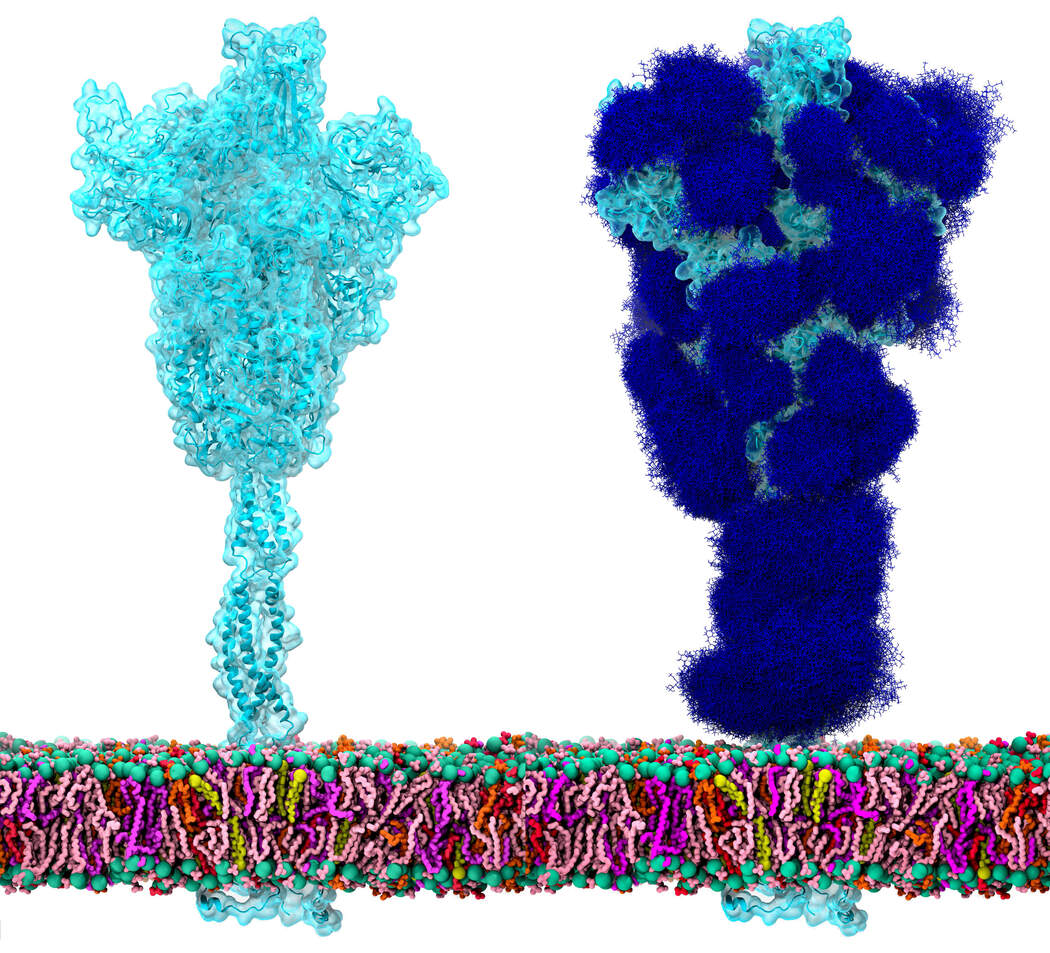
spike protein and protective coating of sugars

Schematic of the full-length SARS-CoV-2 S protein primary structure
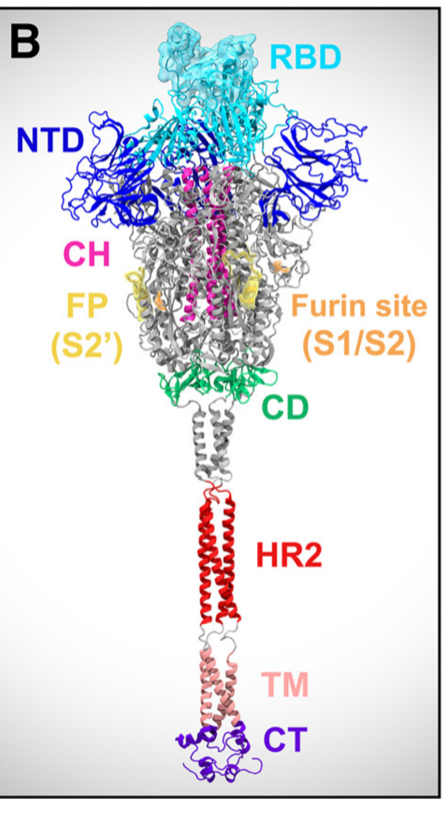
(A) Schematic of the full-length SARS-CoV-2 S protein primary structure colored by domain: N-terminal domain (NTD, 16–291), receptor binding domain (RBD, 330–530), furin cleavage site (S1/S2), fusion peptide (FP, 817–834), central helix (CH, 987–1034), connecting domain (CD, 1080–1135), heptad repeat 2 (HR2, 1163–1210) domain, transmembrane domain (TM, 1214–1234), and cytoplasmic tail (CT, 1235–1273). Representative icons for N-glycans (blue and green) and O-glycan (yellow) are also depicted according to their position in the sequence.
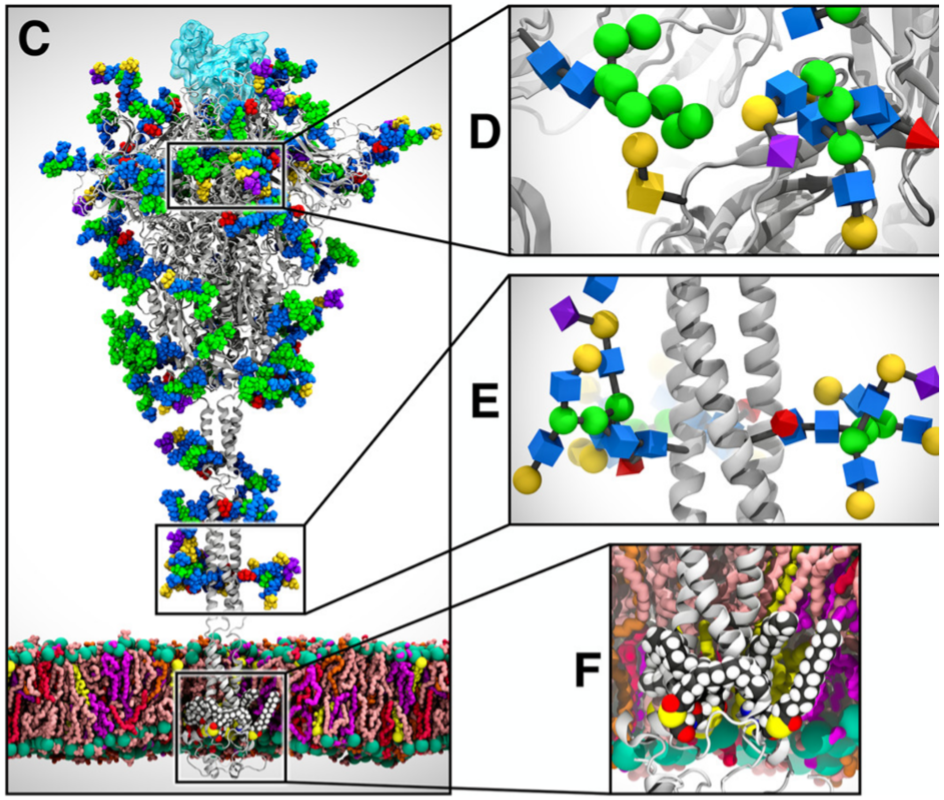
Glycosylated and palmitoylated S protein model
(D) Magnified view of the S protein head glycosylation, where glycans are depicted using the Symbol Nomenclature for Glycans (SNFG).
(E) Magnified view of the S protein stalk glycosylation.
(F) Magnified view of the S protein S-palmitoylation within CT.
Source: Beyond Shielding: The Roles of Glycans in the SARS-CoV-2 Spike Protein, Lorenzo Casalino, Zied Gaieb, Jory A. Goldsmith, Christy K. Hjorth, Abigail C. Dommer, Aoife M. Harbison, Carl A. Fogarty, Emilia P. Barros, Bryn C. Taylor, Jason S. McLellan, Elisa Fadda, and Rommie E. Amaro, ACS Cent. Sci. 2020, 6, 10, 1722–1734, September 23, 2020. https://doi.org/10.1021/acscentsci.0c01056 © 2020 American Chemical Society.
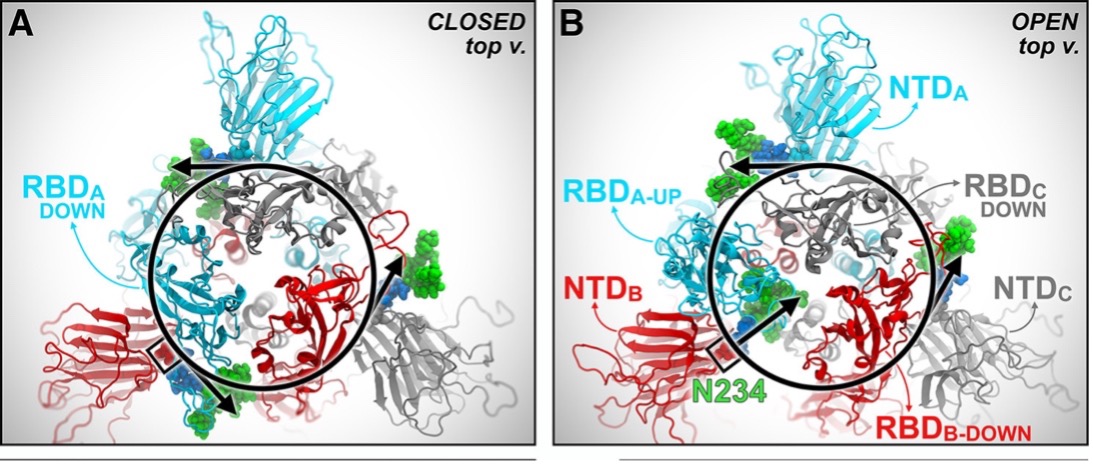
N234A and N165A mutations
In Closed (A), all the N-glycans at N234 are tangential to a hypothetical circle going through N234. In Open (B), the N-glycan at N234 of NTD-B moves inward, filling in the vacancy under RBD-A in the “up” conformation.
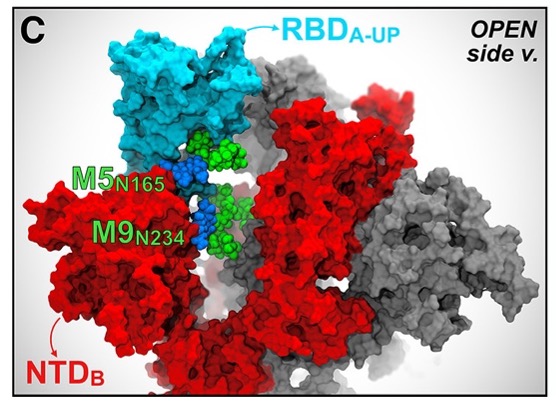
Side view of the S protein
Source: ACS Cent. Sci. 2020, 6, 10, 1722–1734
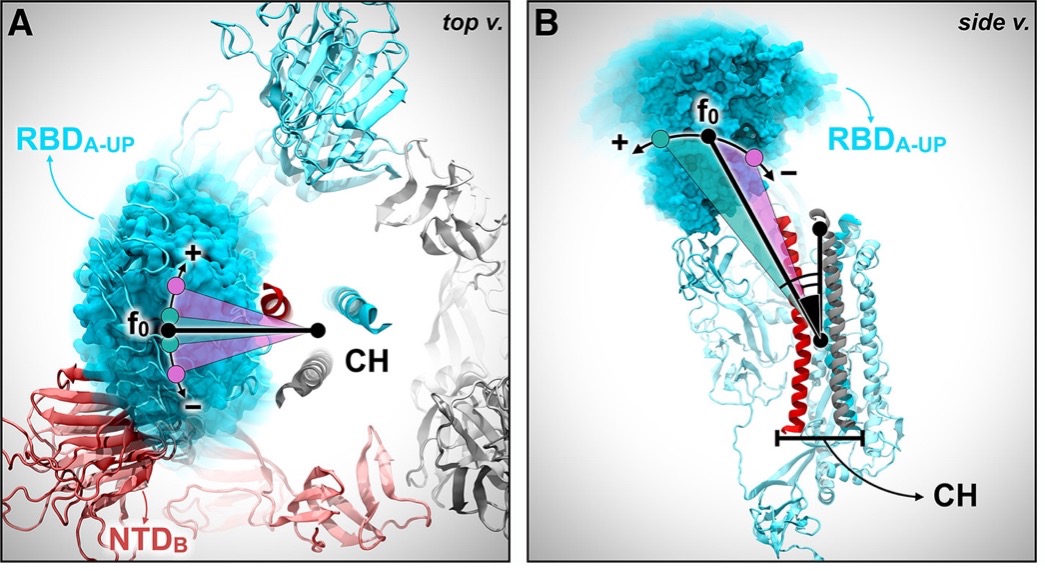
RBD-A lateral- and axial-angle fluctuations.
Source: ACS Cent. Sci. 2020, 6, 10, 1722–1734
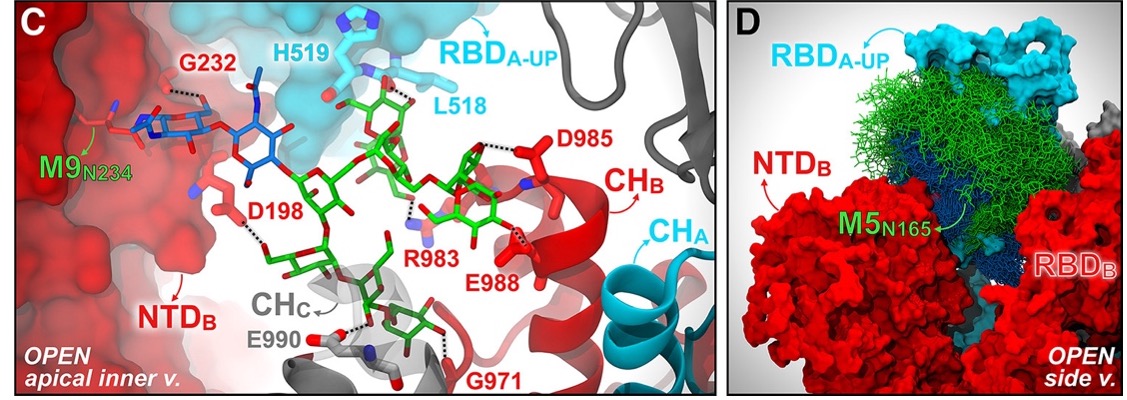
Hydrogen bond interactions of N-glycans at N234 and N165
(C) A snapshot capturing Man9 glycan at N234 (licorice representation) within NTD-B establishing multiple hydrogen bonds with S protein residues (thicker licorice representation) belonging to RBD-A (cyan surface), NTD-B (red surface), CH-B (red), and CH-C (gray). GlcNAc and mannose carbons are colored in blue and green, respectively.
(D) Molecular representation of Man5 glycan at N165 within NTD-B interacting with RBD-A. Multiple (1000) equally interspersed configurations (selected across all replicas) of the glycan at N165 from NTD-B are simultaneously shown. The glycan is represented as colored licorices (GlcNAc in blue, mannose in green), whereas RBD-A and NTD-B are represented as cyan and red surfaces, respectively.
Source: ACS Cent. Sci. 2020, 6, 10, 1722–1734
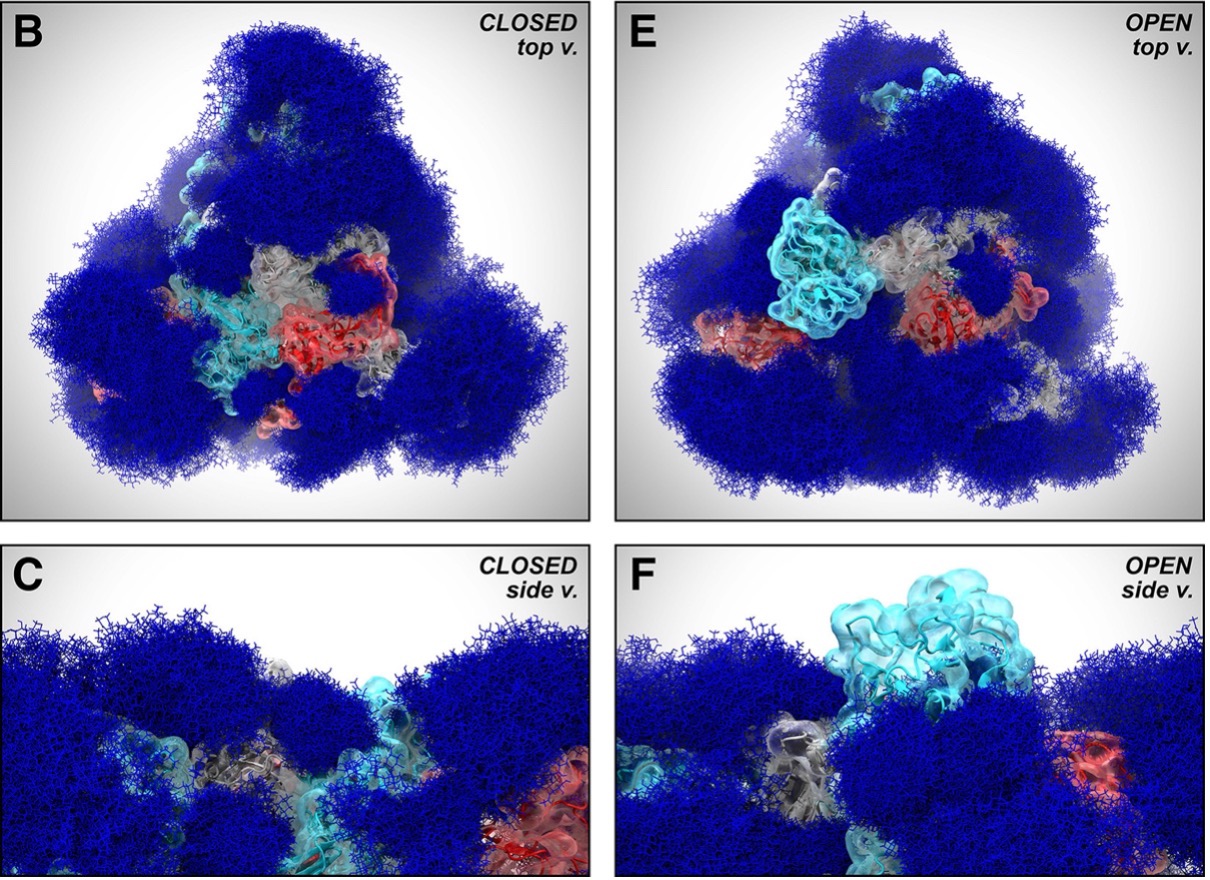
Glycan shield; RBD ACE2-interacting region.
Source: ACS Cent. Sci. 2020, 6, 10, 1722–1734
How the coronavirus invades cells
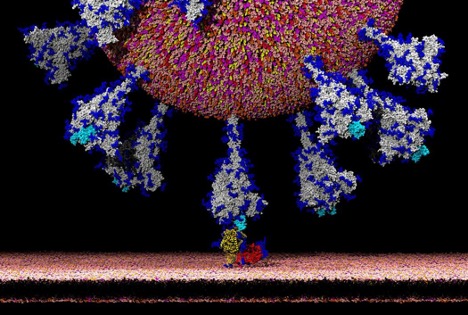
SARSW-CoV-2 coronavirus invasion
Coronavirus spike proteins (turquoise) projecting from the surface of SARS-CoV-2, the virus that causes COVID-19. The protein is glycosylated and its glycans are shown in orange.
Source: Solodovnikov, Alexey; Arkhipova, Valeria (29 July 2021). “Достоверно красиво: как мы сделали 3D-модель SARS-CoV-2” [Truly beautiful: how we made the SARS-CoV-2 3D model] (in Russian). N+1. Archived from the original on 30 July 2021. Retrieved 30 July 2021 Wikipedia
A computer simulation of the structure of the coronavirus SARS-CoV-2.Credit: Janet Iwasa, University of Utah
The coronavirus sports a luxurious sugar coat. Computer simulation of one of the spike proteins of SARS-CoV-2, which stick out from the virus’s surface shows it swathed in sugar molecules, known as glycans.
Spike head based on pdb 6vsb; spike stalk using homology modeling; glycoprofile designed according to Walls et al. 2019 Cell, and Watanabe et al. 2020 biorXiv
Within an hour, one researcher asked in a comment: what was the naked, uncoated loop sticking out of the top of the protein? Ten minutes later a structural biologist at the University of Texas at Austin identified the uncoated loop as a receptor binding domain (RBD), one of three sections of the spike that bind to receptors on human cells
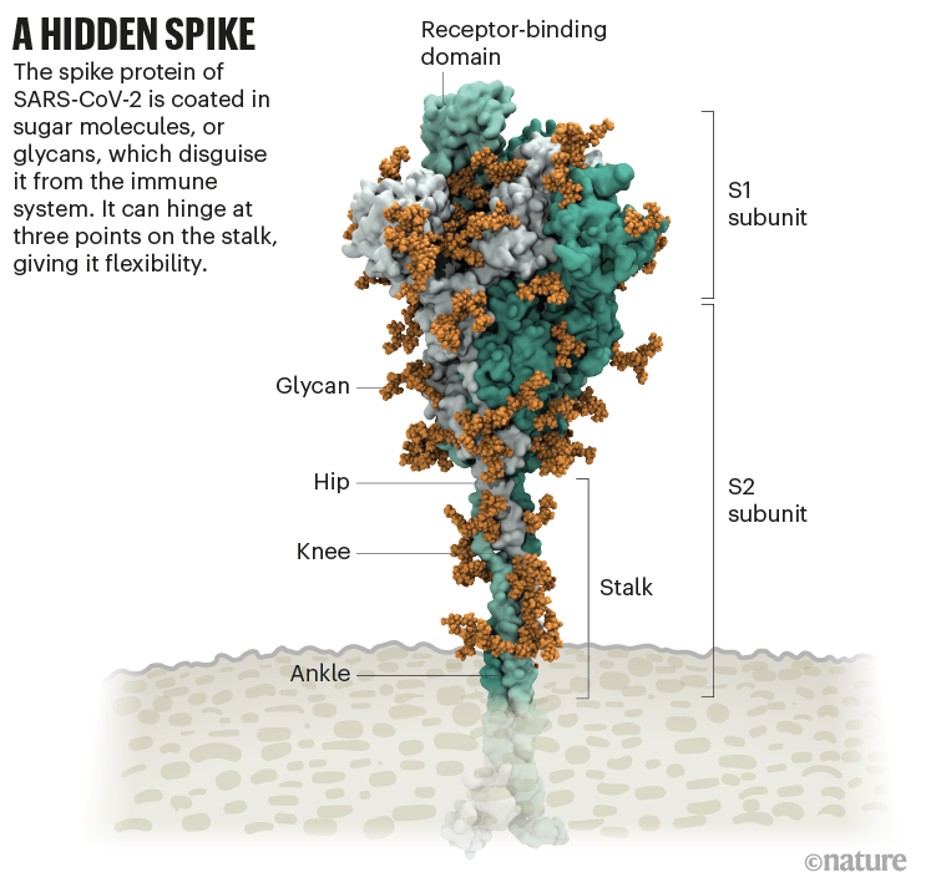
The hidden spike
Source: Structural image from Lorenzo Casalino, Univ. California, San Diego;
In the simulation, when the RBD lifted up above the glycan cloud, two glycans swooped in to lock it into place,
Using simulations to SEE THE UNSEEN
Our work showing #SARSCoV2 spike glycan shield & how it modulates dynamics & host cell binding is out! https://t.co/aiMZA5ctb0@ElisaTelisa @McLellan_Lab @LCasalino88 @zied_gaieb @EmiliaPBarros @biobryn @2016Carl @abbydommer @ACSCentSci pic.twitter.com/BFkfAex8Kd
— Rommie Amaro (@RommieAmaro) September 23, 2020
Scientists have discovered key adaptations that help the virus to grab on to human cells with surprising strength and then hide itself once inside. Later, as it leaves cells, SARS-CoV-2 executes a crucial processing step to prepare its particles for infecting even more human cells.

Life cycle of pandemic coronavirus
Source: Hui (Ann) Liu, Univ. Utah;
How the coronavirus infects cells
It starts with the spikes. Each SARS-CoV-2 virion (virus particle) has an outer surface covered with 24–40 randomly arranged spike proteins that are its key to fusing with human cells. For other types of virus, such as influenza, external fusion proteins are relatively rigid. SARS-CoV-2 spikes, however, are flexible and hinge at three points.
That allows the spikes to sway and rotate, which makes it easier for them to scan the cell surface and for multiple spikes to bind to a human cell. There are no similar experimental data for other coronaviruses, but because spike-protein sequences are highly evolutionarily conserved, it is fair to assume the trait is shared.
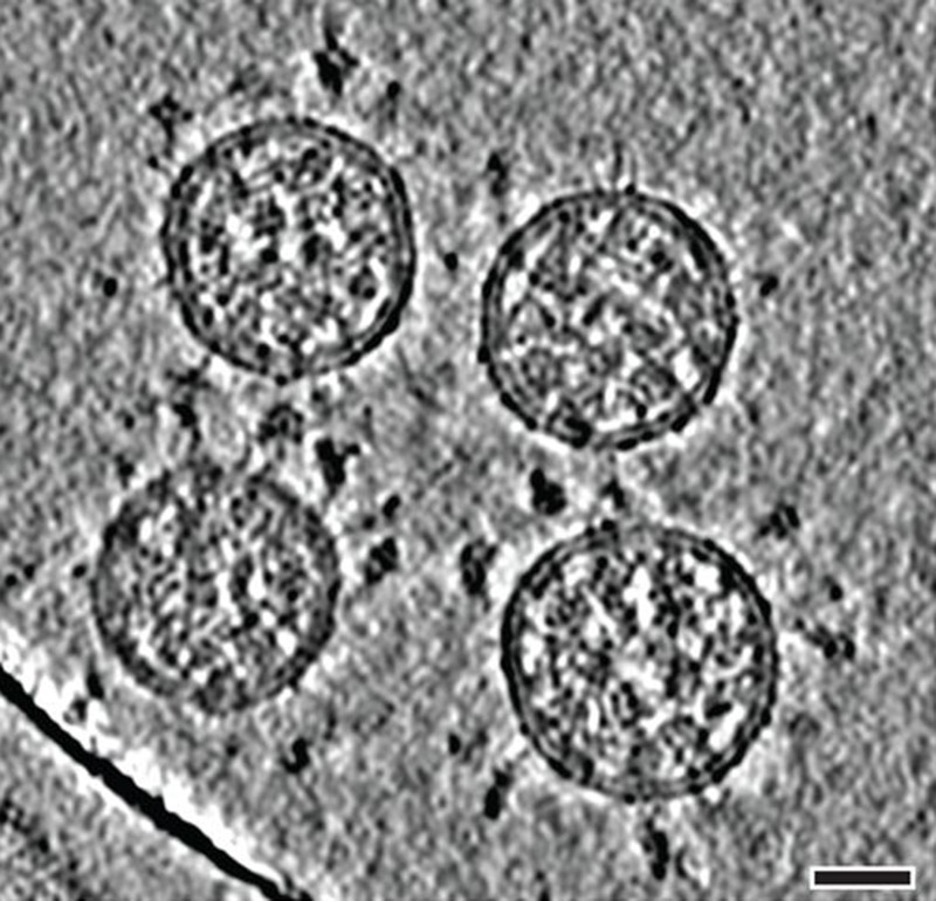
cryoET images of virions
Credit: B. Turoňová et al./Science
The RBDs of SARS-CoV-2 spike proteins attach to a familiar protein called the ACE2 receptor, which adorns the outside of most human throat and lung cells. This receptor is also the docking point for SARS-CoV, the virus that causes severe acute respiratory syndrome (SARS). But compared with SARS-CoV, SARS-CoV-2 binds to ACE2 an estimated 2–4 times more strongly, because several changes in the RBD stabilize its virus-binding hotspots.
Barbed and ready
Variants of SARS-CoV-2 tend to have mutations in the S1 subunit of the spike protein, which hosts the RBDs and is responsible for binding to the ACE2 receptor. A second spike subunit, S2, prompts viral fusion with the host cell’s membrane.
The Alpha variant, for example, includes ten changes in the spike-protein sequence, which result in RBDs being more likely to stay in the ‘up’ position.
The Delta variant hosts multiple mutations in the S1 subunit, including three in the RBD that seem to improve the RBD’s ability to bind to ACE2 and evade the immune system.
Restricted entry
Once the viral spikes bind to ACE2, other proteins on the host cell’s surface initiate a process that leads to the merging of viral and cell membranes.
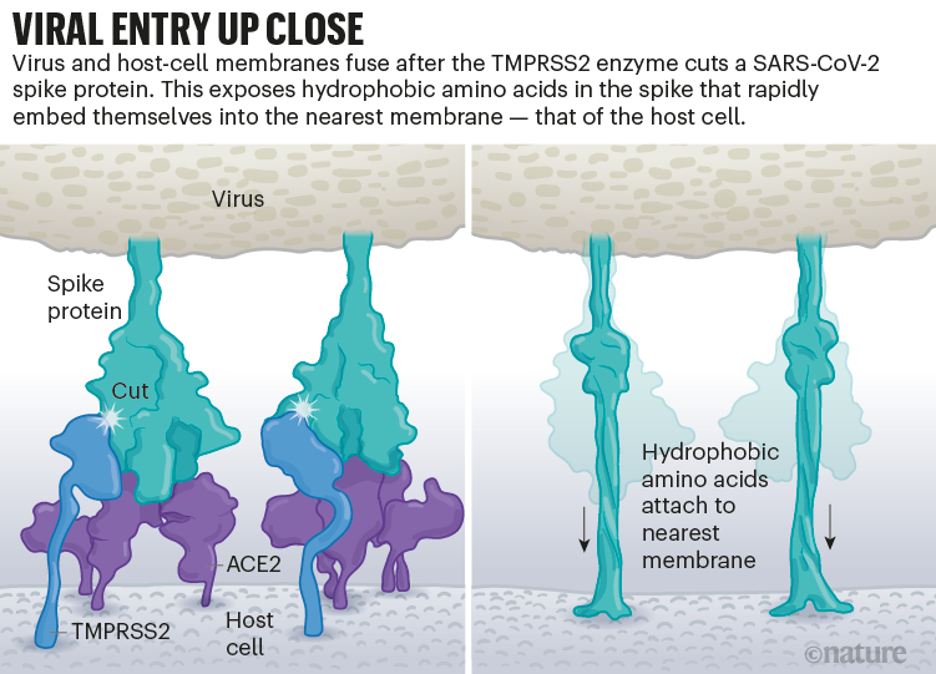
Viral entry
Source: Janet Iwasa, Univ. Utah;
The virus that causes SARS, SARS-CoV, uses either of two host protease enzymes to break in: TMPRSS2 (pronounced ‘tempress two’) or cathepsin L. TMPRSS2 is the faster route in, but SARS-CoV often enters instead through an endosome — a lipid-surrounded bubble — which relies on cathepsin L. When virions enter cells by this route, however, antiviral proteins can trap them.
SARS-CoV-2 differs from SARS-CoV because it efficiently uses TMPRSS2, an enzyme found in high amounts on the outside of respiratory cells. First, TMPRSS2 cuts a site on the spike’s S2 subunit8. That cut exposes a run of hydrophobic amino acids that rapidly buries itself in the closest membrane — that of the host cell. Next, the extended spike folds back onto itself, like a zipper, forcing the viral and cell membranes to fuse.
An animation of the way SARS-CoV-2 fuses with cells. Credit: Janet Iwasa, University of Utah
The virus then ejects its genome directly into the cell. By invading in this spring-loaded manner, SARS-CoV-2 infects faster than SARS-CoV and avoids being trapped in endosomes.
The virus’s speedy entry using TMPRSS2 explains why the malaria drug chloroquine didn’t work in clinical trials as a COVID-19 treatment, despite early promising studies in the lab10. Those turned out to have used cells that rely exclusively on cathepsins for endosomal entry. When the SARS-CoV-2 coronavirus transmits and replicates in the human airway, it doesn’t use endosomes, so chloroquine, which is an endosomal disrupting drug, is not effective.
Deadly competition
One of the defining features of coronavirus biology is the coordinated process by which the virus binds and enters the host cell, which involves both docking to receptors at the cell surface (ACE2 for SARS-CoV2), and proteolytic activation of the spike protein by host encoded proteases at two distinct sites.
One activation step is spike cleavage at the S1–S2 boundary, which can occur either before or after receptor binding. A second proteolytic activation exposes the S2 portion, and primes S2 for fusion of virus and cellular membranes. The protease priming event at this S2′ site and subsequent fusion can occur after endocytosis, in which cleavage is carried out by endosomal low pH-activated proteases such as cathepsin B and cathepsin L7, or at the plasma membrane, where cleavage can be mediated by TMPRSS2.
After the virus inserts its RNA genome into the cell, ribosomes in the cytoplasm translate two sections of viral RNA into long strings of amino acids, which are then snipped into 16 proteins, including many involved in RNA synthesis. Later, more RNAs are generated that code for a total of 26 known viral proteins, including structural ones used to make new virus particles, such as the spike, and other accessory proteins. In this way, the virus begins churning out copies of its own messenger RNA. But it needs the cell’s machinery to translate those mRNAs into proteins.
How a rampant coronavirus variant blunts our immune defenses
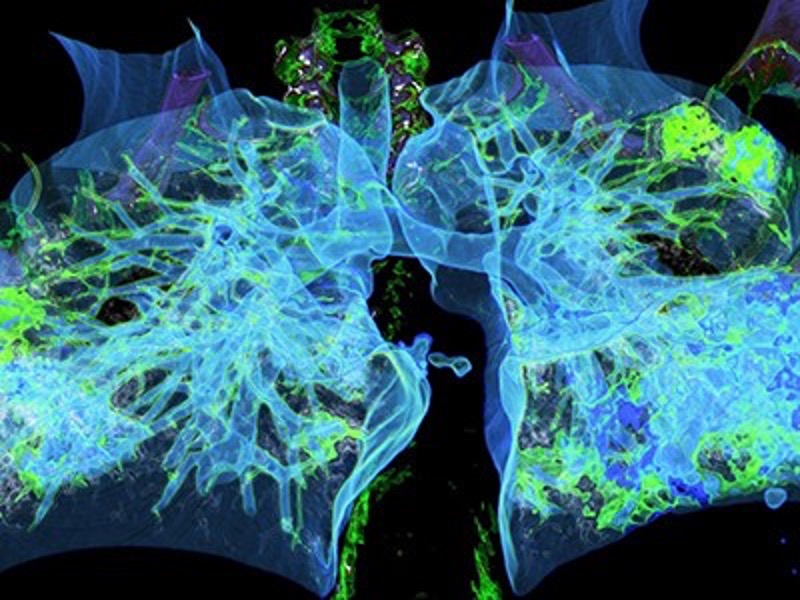
widespread lung damage
Widespread lung damage (green; artificially coloured computed tomography scan) indicates pneumonia in a person with COVID-19.Credit: Vsevolod Zviryk/SPL
Coronaviruses take over that machinery in many ways.
First, the virus eliminates the competition: viral protein Nsp1, one of the first proteins translated when the virus arrives, recruits host proteins to systematically chop up all cellular mRNAs that don’t have a viral tag.
Second, infection reduces overall protein translation in the cell by 70%. Nsp1 is again the main culprit, this time physically blocking the entry channel of ribosomes so mRNA can’t get inside. The little translation capacity that remains is dedicated to viral RNAs.
Finally, the virus shuts down the cell’s alarm system. In SARS-CoV-2, the virus prevents cellular mRNA from getting out of the nucleus, including instructions for proteins meant to alert the immune system to infection. Nsp1: the protein seems to jam up exit channels in the nucleus so nothing can escape.
Because gene transcripts can’t get out of the nucleus, the infected cells don’t release many interferons — the signalling proteins that alert the immune system to the presence of a virus. SARS-Cov-2 is particularly efficient at shutting down this alarm system compared with other respiratory viruses, including SARS-CoV and respiratory syncytial virus. SARS-CoV-2 infection induces significantly lower levels of interferons.
By the time the immune system does realize there is a virus, there is so much of it that immune-response proteins sometimes flood the bloodstream at a faster rate than normal — which can cause damage. Doctors saw early in the pandemic that some people with COVID-19 who become very ill were harmed by an overactive immune response to SARS-CoV-2, as well as by the virus itself.
Syncytia
Once the virus has taken over host translation, it starts extensively remodelling the interior and exterior of the cell to its needs.
First, some of the newly made viral spike proteins travel to the surface of the cell and poke out of the host-cell membrane. There, they activate a host calcium-ion channel, which expels a fatty coating onto the outside of the cell — the same coating found on cells that naturally fuse together, such as muscle cells. At this point, the infected cell fuses to neighboring cells expressing ACE2, developing into massive individual respiratory cells filled with up to 20 nuclei.

syncytia: fused cell structures
https://media.nature.com/lw800/magazine-assets/d41586-021-02039-y/d41586-021-02039-y_19386278.jpg
One of the defining features of coronavirus biology is the coordinated process by which the virus binds and enters the host cell, which involves both docking to receptors at the cell surface (ACE2 for SARS-CoV2), and proteolytic activation of the spike protein by host encoded proteases at two distinct sites. One activation step is spike cleavage at the S1–S2 boundary, which can occur either before or after receptor binding. A second proteolytic activation exposes the S2 portion, and primes S2 for fusion of virus and cellular membranes. The protease priming event at this S2′ site and subsequent fusion can occur after endocytosis, in which cleavage is carried out by endosomal low pH-activated proteases such as cathepsin B and cathepsin L, or at the plasma membrane, where cleavage can be mediated by TMPRSS2.
The spike proteins of MERS-CoV and SARS-CoV-2 possess a multibasic amino acid sequence at the S1–S2 interface, which is not present in SARS-CoV, that also allows cleavage by the ubiquitously expressed serine protease furin. As a consequence, cells that express MERS-CoV and SARS-CoV-2 spike protein at the plasma membrane can fuse with other cells that express the respective receptors and form syncytia which are multinucleate cell which can result from multiple cell fusions of uninuclear cells. Usually these syncytia are the result of expression of a viral fusion protein at the host cell membrane during viral replication
It is hypothesized that forming syncytia allows infected cells to thrive for long periods of time, churning out more and more virions. Some COVID-19-infected cells even form syncytia with lymphocytes — one of the body’s own immune cells. This is a known mechanism of immune evasion by tumour cells, but not by viruses. It suggests that infected cells avoid immune detection by simply grabbing on to and merging with nearby immune scouts. https://www.nature.com/articles/s41586-021-03491-6
On the inside of the cell, even more change is occurring. Like other coronaviruses, SARS-CoV-2 transforms the long, thin endoplasmic reticulum (ER), a network of flat membranes involved in protein synthesis and transport, into double-membrane spheres, as if the ER were blowing bubbles. These double-membrane vesicles (DMVs) might provide a safe place for viral RNA to be replicated and translated, shielding it from innate immune sensors in the cell, but that hypothesis is still being investigated.
The coronavirus transmembrane protein Nsp3 creates a crown-like pore in the walls of the DMVs to shuttle out newly made viral RNA.
Most viruses that have an outer wrapping, known as an envelope, form this feature by assembly directly at the edge of the cell, co-opting some of the cell’s own plasma membrane on their way out. But newly made coronavirus proteins take a different path.
For years, evidence has suggested that coronaviruses are transported out of the cell through the Golgi complex, an organelle that works like a post office, packaging molecules in membranes and sending them off to other parts of the cell. There, the virus forms a lipid envelope from the Golgi complex’s membrane; newly formed virions are then carried inside Golgi vesicles to the cell surface, where they are spat out of the cell.
But in December, 2020, cell biologists reported that they had detected coronaviruses leaving the cell through lysosomes — cellular rubbish bins full of enzymes that break down cell parts. Blocking the Golgi-based secretory pathway didn’t seem to affect the amount of infectious virus being released, and the evidence from this research suggests that viral proteins form an envelope by budding into the ER, then take over lysosomes to get out of the cell.
Leaving a cell through either the Golgi or lysosomes is slow and inefficient compared with budding out of a plasma membrane, but it is suspected that the lipid composition of a Golgi- or lysosome-derived envelope is somehow more beneficial to the virus than one from the plasma membrane.
A final slice
On the way out of the cell, a quick snip at a site of five amino acids prepares the virus to strike its next target.
Where other coronaviruses have a single arginine amino acid at the junction of the S1 and S2 subunits of the spike, SARS-CoV-2 has a line of five amino acids: proline, arginine, arginine, alanine and arginine. This unusual site is essential for invasion of lung cells. A host-cell protein called furin recognizes and clips that string of amino acids — and the cut is “essential” for the virus to enter human lung cells efficiently.
Furin is suspected to cut the site at some point during virion assembly, or just before release. The timing might explain why the virus exits through the Golgi or lysosomes. The virus, once assembled, moves into an organelle where it can be bathed in the presence of the furin protease.”
By snipping the bond between the S1 and S2 subunits, the furin cut loosens up virion spike proteins so that during cell entry they respond to a second cut by TMPRSS2, which exposes the hydrophobic area that rapidly buries itself in a host-cell membrane. If spikes are not pre-clipped by furin —and they aren’t always — they bypass TMPRSS2, and enter through the slower endosomal pathway, if at all.
Two coronavirus variants, Alpha and Delta, have altered furin cleavage sites. In the Alpha variant, the initial proline amino acid is changed to a histidine (P681H); in the Delta variant, it is changed to an arginine (P681R). Both changes make the sequence less acidic, and the more basic the string of amino acids, the more effectively furin recognizes and cuts it.
More furin cuts mean more spike proteins primed to enter human cells. In SARS-CoV, less than 10% of spike proteins are primed. In SARS-CoV-2, that percentage rises to 50%. In the Alpha variant, it’s more than 50%. In the highly transmissible Delta variant, greater than 75% of spikes are primed to infect a human cell.
Some portions of this page have been adapted from: Nature 595, 640-644 (2021) doi: https://doi.org/10.1038/d41586-021-02039-y
Mutants/variants of the coronavirus spike
Updated: September 3, 2022
Prior to the emergence of new mutants of the coronavirus, the SARS-CoV-2 variant named D614G had already mutated from the original SARS-CoV-2 pathogen that triggered the pandemic.

spike protein model (closed configuration)
During the evolution of SARS-CoV-2 in humans a D614G substitution in the spike (S) protein emerged and became the predominant circulating variant (S-614G) of the COVID-19 pandemic.
In a recent multinational study, researchers demonstrated that the S-614G variant has (i) enhanced binding to human host cell surface receptor angiotensin-converting enzyme 2 (ACE2), (ii) increased replication in primary human bronchial and nasal airway epithelial cultures as well as in a novel human ACE2 knock-in mouse model, and (iii) markedly increased replication and transmissibility in hamster and ferret models of SARS-CoV-2 infection. Collectively, the data showed that the S-614G substitution provides a real competitive advantage in vivo, particularly during the transmission bottle neck, providing an explanation for the global predominance of S-614G variant among the SARS-CoV-2 viruses currently circulating. Science 25 Sep 2020: Vol. 369, Issue 6511, pp. 1586-1592; DOI: 10.1126/science.abd4251
Evolution/mutation of the coronavirus spike
A study published by scientists at Boston Children’s Hospital show that the structure of the coronavirus spike proteins changes with the D614G mutation carried by all three variants— UK, South Africa, and Brazil— and may explain why these variants are able to spread more quickly. Science 25 Sep 2020: Vol. 369, Issue 6511, pp. 1586-1592 DOI: 10.1126/science.abd4251
Model for structural rearrangements of SARS-Cov-2 S protein.
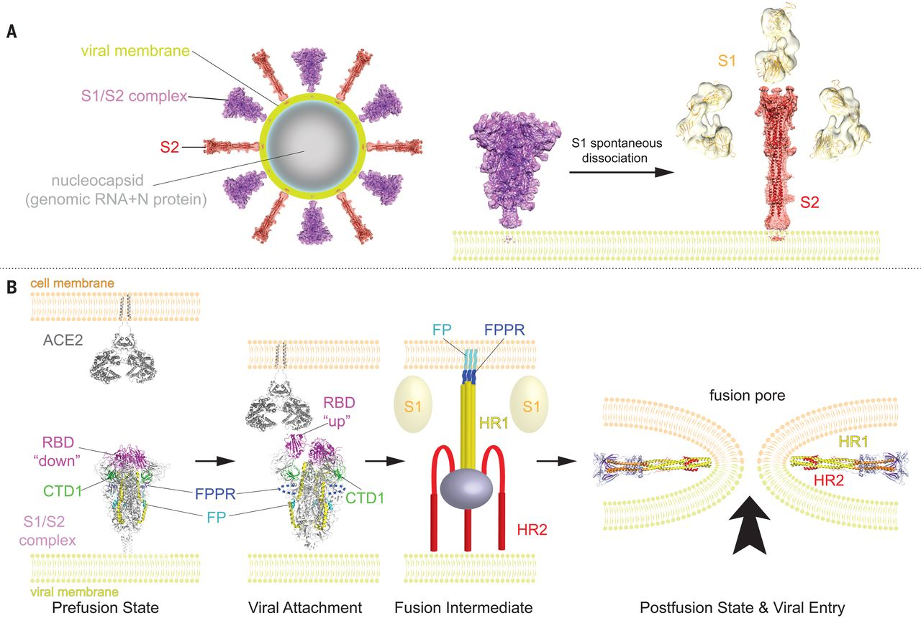
COVID-19 structural rearrangements model
(B) ACE2-dependent structural rearrangements. Structural transition from the prefusion to postfusion conformation inducing membrane fusion likely proceeds stepwise as follows.
First, FPPR clamps down RBD through CTD1 in the prefusion S trimer (this study) but occasionally flips out of position and allows an RBD to sample the up conformation (PDB ID: 6vyb).
Second, RBD binding to ACE2 (PDB ID: 6m17) creates a flexible FPPR that enables exposure of the S2′ cleavage site immediately upstream of the adjacent FP. Cleavage at the S2′ site, and perhaps also the S1/S2 site, releases the structural constraints on the fusion peptide and initiates a cascade of refolding events in S2, probably accompanied by complete dissociation of S1.
Third, the long, central, three-stranded coiled coil forms and HR2 folds back.
Finally, the postfusion structure of S2 (this study) forms, which brings the two membranes together, facilitating formation of a fusion pore and viral entry. Science 25 Sep 2020: Vol. 369, Issue 6511, pp. 1586-1592 DOI: 10.1126/science.abd4251
The omicron variant
Updated December 3, 2021
The Omicron (B.1.1.529.1) variant, first reported on November 24, 2021, was quickly identified as a variant of concern with potential to spread rapidly across the world. The Omicron variant spike protein has 3-5 times more mutations than that seen in any of the previous SARS-CoV-2 strains. Analysis of the sequence of the Omicron genome suggests that it is not derived from any of the currently circulating variants, and may have a different origin and only recently emerged in humans.
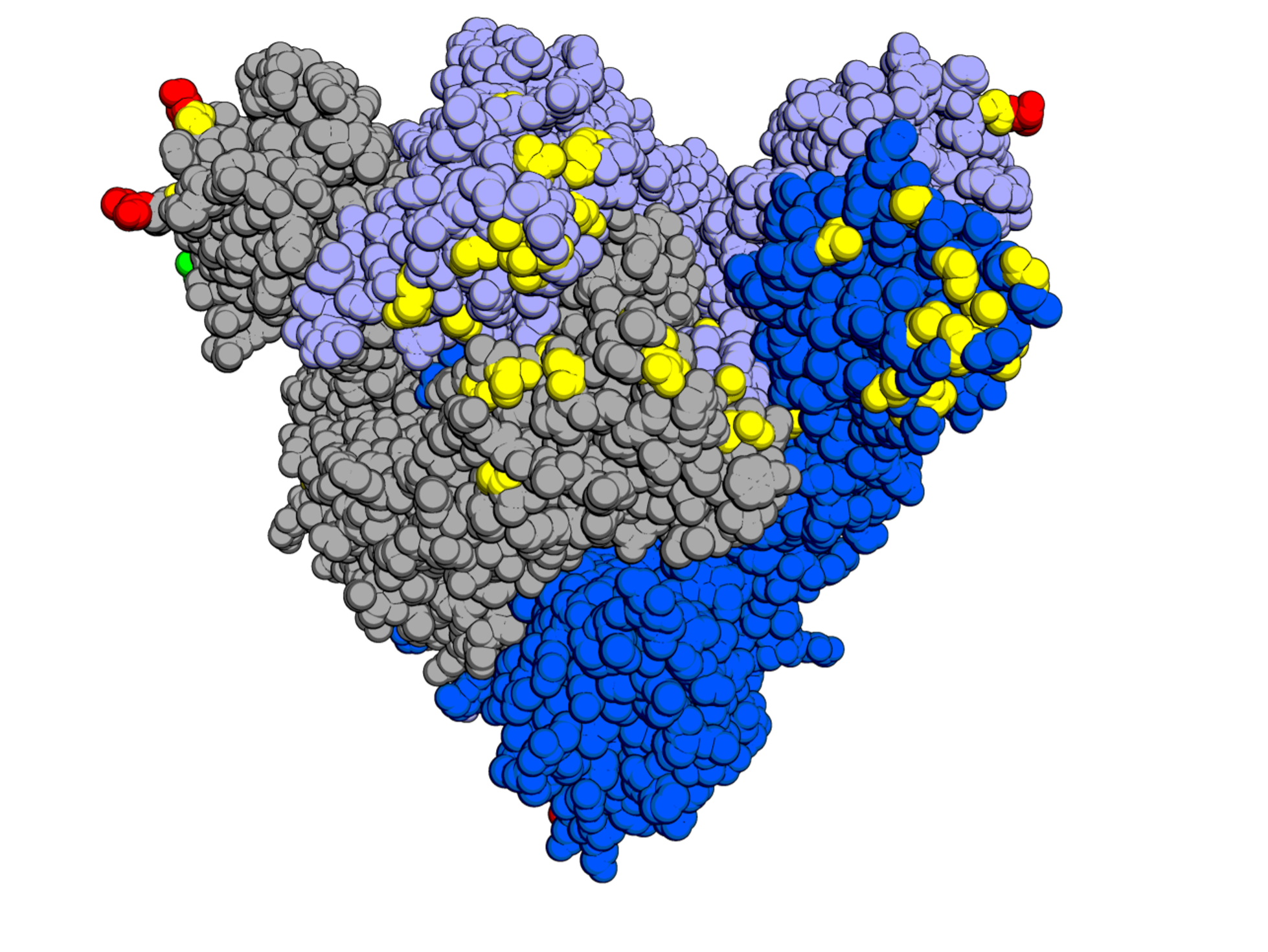
Mutations in the Omicron variant (top view)
Locations of the Omicron mutations (top view)
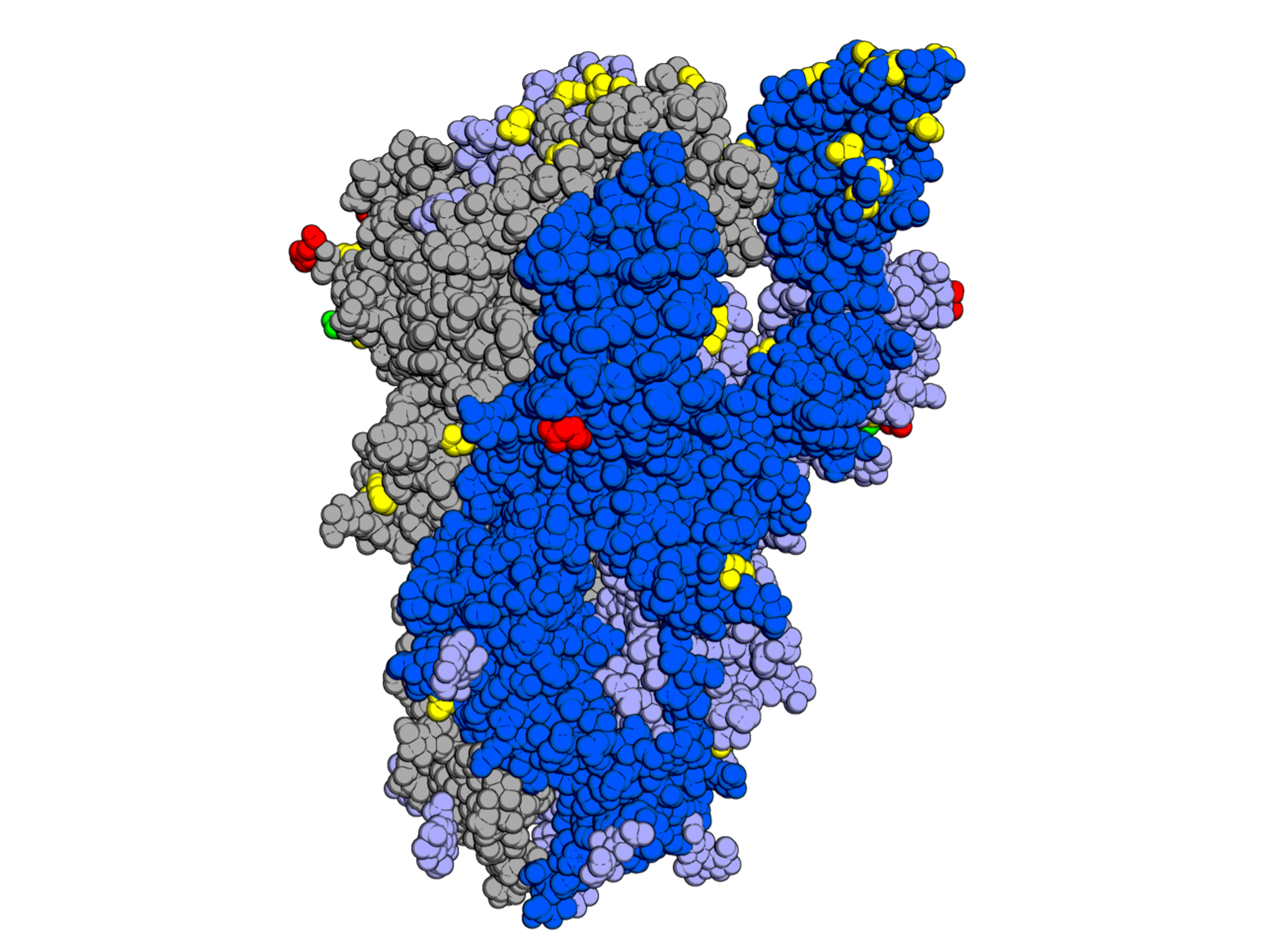
Mutations in the Omicron variant (side view)
Locations of the Omicron mutations in the side view
Positions of mutations in the SARS-CoV-2 Omicron variant spike protein showing amino acid substitutions (yellow), deletions (red), and insertions (green). In this trimeric structure, two monomers (gray and light blue) have their receptor-binding domains in the “down” conformation while one (dark blue) is in the “up” or “open” conformation.
“Top” view is looking toward the membrane and shows the receptor-binding domains. Mutation data from WHO, structure from PDB: 6VYB.
Walls, Alexandra C.; Park, Young-Jun; Tortorici, M. Alejandra; Wall, Abigail; McGuire, Andrew T.; Veesler, David (April 2020). “Structure, Function, and Antigenicity of the SARS-CoV-2 Spike Glycoprotein”. Cell. 181 (2): 281–292.e6. doi:10.1016/j.cell.2020.02.058. PMC 7102599. PMID 32155444.
Structural modeling of the viral genetic changes indicates that the virus has mutations that change the shape of all four of the sites where neutralizing antibodies lock onto it, making it likely that it can evade natural immunity.
Omicron’s mutations appear to help the virus replicate more quickly in the body and may help it bind more tightly to the ACE2 receptor on human cells. Based on the same structural modeling, Omicron may escape at least some of the protection people obtain from COVID-19 vaccines.

Comparison of variants
Cryo-EM structural analysis of the Omicron variant spike protein in complex with human ACE2 reveals new salt bridges and hydrogen bonds formed by mutated residues R493, S496 and R498 in the RBD with ACE2. These interactions appear to compensate for other Omicron mutations such as K417N known to reduce ACE2 binding affinity, explaining our finding of similar biochemical ACE2 binding affinities for Delta and Omicron variants. Neutralization assays show that pseudoviruses displaying the Omicron spike protein exhibit increased antibody evasion, with greater evasion observed in sera obtained from unvaccinated convalescent patients as compared to doubly vaccinated individuals (8- vs 3-fold). The retention of strong interactions at the ACE2 interface and the increase in antibody evasion are molecular factors that likely contribute to the increased transmissibility of the Omicron variant.
The Omicron variant has 37 mutations in the spike protein relative to the initial Wuhan strain, with 15 of them present in the receptor binding domain (RBD). The RBD is the region of the spike protein that mediates both attachment to human cells via the ACE2 receptor and is the primary target of neutralizing antibodies. The Delta variant, which was the predominant SARS-CoV-2 lineage until the emergence of Omicron, has 7 mutations in the spike protein relative to the Wuhan strain but only two of these mutations (T478K and D614G) are in common with the Omicron strain.
The Omicron variant structure
A schematic diagram illustrating the domain arrangement of the spike protein. Mutations present in the Omicron variant spike protein are labeled.

Omicron spike domains
Cryo-EM structural analysis of the Omicron spike protein ectodomain shows that the overall organization of the trimer is similar to that observed for the ancestral strain and all earlier variants.
Cryo-EM map of the Omicron spike protein at 2.79 Å. Protomers are coloured in shades of purple.
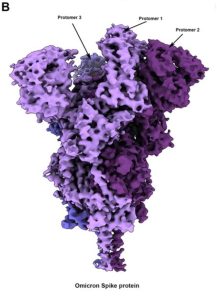
Omicron spike protein
The RBD in one of the protomers (protomer 1) is well-resolved and is in the “down” position, while the other two RBDs are less well-resolved because they are flexible relative to the rest of the spike protein polypeptide. The mutations in the Omicron variant spike protein are distributed both on the surface and the interior of the spike protein.
Cryo-EM structure of Omicron spike protein indicating the locations of all mutations on one protomer.
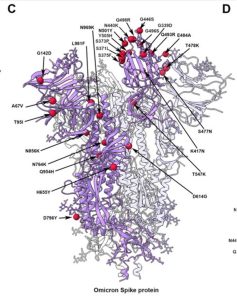
Omicron spike protein (ribbon)
The mutations in the RBD are predominantly distributed on one face of the domain which spans regions that bind ACE2 as well as those that form epitopes for numerous broadly neutralizing antibodies.
The Omicron spike receptor-binding domain (RBD) shown in two orthogonal orientations. Cα of all mutated residues are shown as red spheres.
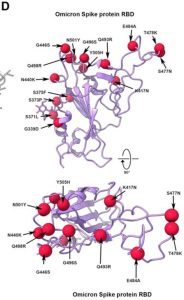
Omicron spike protein RBD
Source: bioRxiv preprint doi: https://doi.org/10.1101/2021.12.19.473380 posted December 21, 2021.
The Omicron variant shares RBD mutations in common with previous variants of concern (K417N, T478K, and N501Y). The N501Y and K417N mutations have been extensively individually characterized for their effect on ACE2 binding, and exhibit increased and decreased ACE2 binding affinity respectively. These mutational effects have been demonstrated to act in a modular fashion, preserving the same general impact on ACE2 affinity when present in isolation or in combination with other RBD mutations. However, the Omicron RBD contains 12 additional mutations which have not yet been characterized in depth for their effect on ACE2 binding affinity, making it difficult to predict the overall change in ACE2 affinity for the Omicron variant.
Cryo-EM structural analysis of the ACE2-Omicron spike protein complex shows strong density for ACE2 bound to the RBD of one of the protomers in the “up” position. Weaker density is observed for a second bound ACE2, suggesting partial occupancy of the second RBD under the conditions of our experiment. The stoichiometry of ACE2 binding can be variable depending on the experimental conditions.
Cryo-EM structure of the Omicron spike protein-ACE2 complex
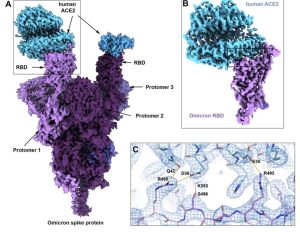
Omicron spike protein cryo-EM map
(B) Cryo-EM map of the Omicron spike RBD in complex with ACE2 at 2.66 Å resolution after focused refinement. The inset box indicates the region highlighted in (C).
(C) Cryo-EM density at the Omicron spike RBD-ACE2 interface, with fitted atomic model. Yellow dashed lines represent hydrogen bonds.
We compare the key interactions at this interface in the Omicron variant with corresponding interactions that we have reported recently for the Delta variant. In the Delta variant-ACE2 complex, there are hydrogen bonds formed by residues Q493 and Q498 on the spike protein with residues E35 and Q42, respectively, on ACE2. In the Omicron variant, three mutations are observed in this stretch: Q493R, G396S and Q498R. Residue R493 replaces the hydrogen bond to ACE2 residue E35 with a new salt bridge, while residue R498 forms a new salt bridge with ACE2 residue D38 in addition to maintaining a hydrogen bonded interaction between residue 498 and ACE2 residue Q42. RBD residue S496 adds a new interaction at the interface by forming a hydrogen bond with ACE2 residue K353.
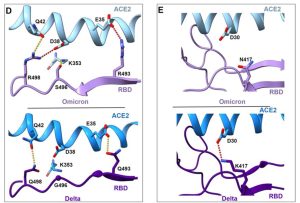
Omicron-Delta comparisons
While these new interactions formed by residues 493, 496 and 498 likely make spikeACE2 binding stronger, this is offset by the loss of a key salt bridge between spike protein residue K417 and ACE2 residue D30 that is present in the Delta variant. In isolation, the K417N mutant displays reduced ACE2 binding affinity (12, 16), but our findings suggest that the new mutations in the Omicron interface have a compensatory effect on the strength of ACE2 binding, providing an explanation for the similar ACE2 binding affinities observed.
Adapted from: SARS-CoV-2 Omicron Variant: ACE2 Binding, Cryo-EM Structure of Spike Protein ACE2 Complex and Antibody Evasion, Dhiraj Mannar, James W. Saville, Xing Zhu, Shanti S. Srivastava,
Alison M. Berezuk1, Katharine S. Tuttle1, Department of Biochemistry and Molecular Biology, University of British Columbia, Vancouver, BC, Canada; Citlali Marquez2, Inna Sekirov. BC Center for Disease Control Public Health Laboratory, Vancouver, BC, Canada; Department of Pathology and Laboratory Medicine, University of British Columbia, Vancouver, BC, Canada and Sriram Subramaniam1, Gandeeva Therapeutics Inc., Vancouver, BC, Canada; bioRxiv preprint doi: https://doi.org/10.1101/2021.12.19.473380 posted December 21, 2021.
The omicron subvariant BA.5 surge
p style =”line-height:1.5; font-size:70%”>
Updated September 3, 2022
These escape strategies include changing the shape of key proteins recognized by your immune system’s protective antibodies.
Using one of the earliest reported SARS-CoV-2 genome sequences (GenBank accession number: MN908947.3) as a control, then 20 nonsynonymous mutations with frequency ≥1% were selected from CNCB 2019nCoVR database. There were 17 types of mutants which included one nsp5, nsp6, nsp7, or nsp13 mutant, two nsp2, nsp12, S, Orf3, or Orf8 mutants and three N mutants. Four mutants exhibited a significant difference in protein structural morphology from their controls.
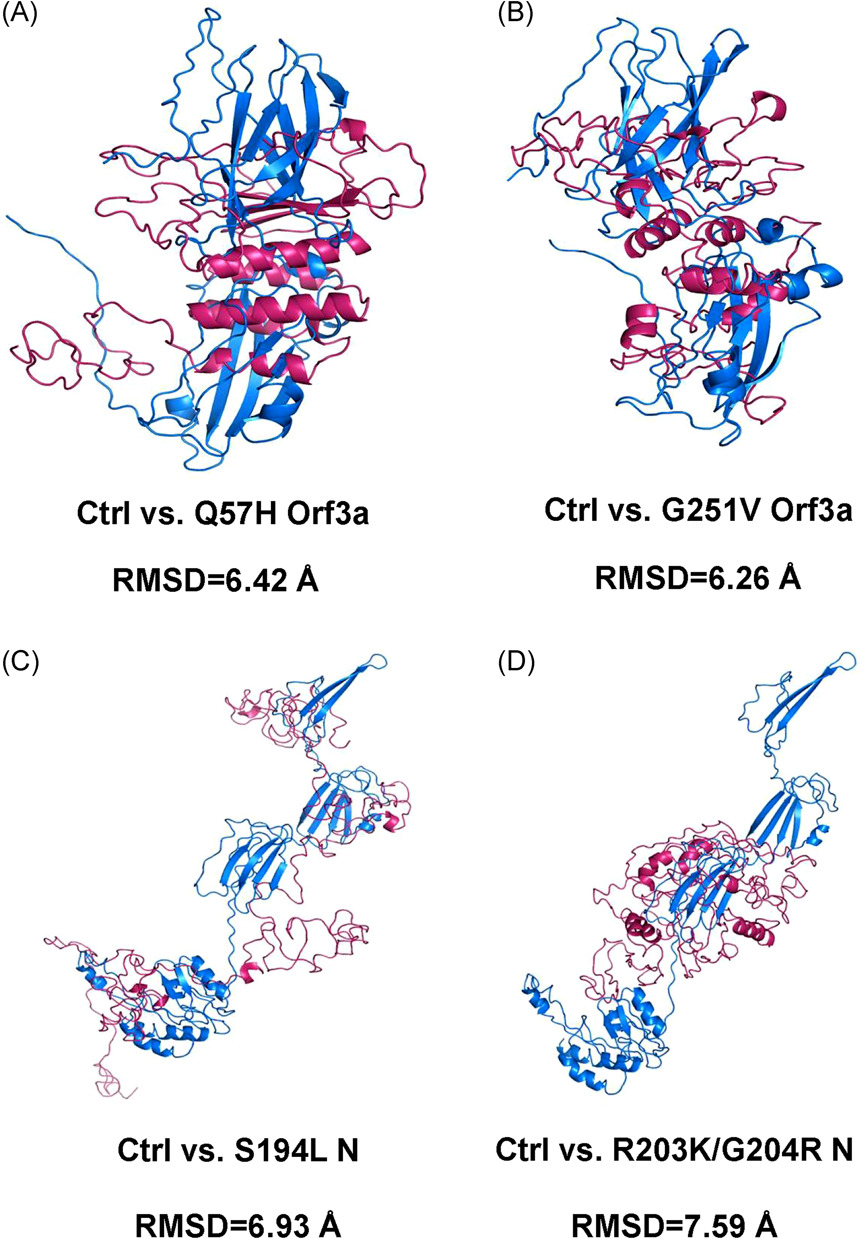
Comparisons of protein structures between SARS-CoV-2 control and mutant proteins
SARS-CoV-2 mutations caused varied hot spots, functional sites within protein-interacting interfaces within protein complexes. The binding hot spots on mutant protein–protein interfaces were notably different from controls and few identical ones were shared by both the mutant and control complexes. These results indicated that SARS-CoV-2 mutations might destroy drug-targeting sites and lead to therapy failure by shifting the protein-binding interface.
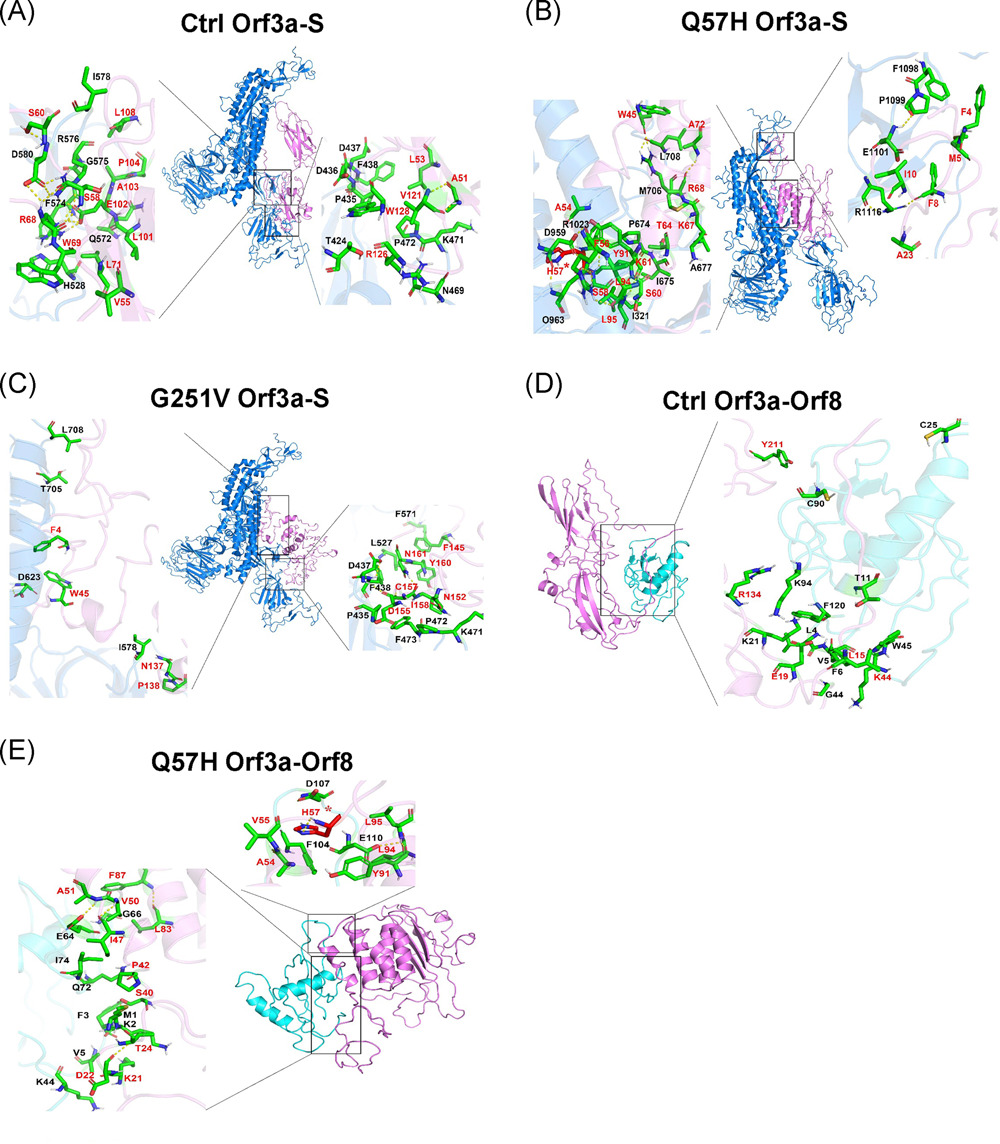
Hot spots within interactions between SARS-CoV-2 Orf3a and S or Orf8.
Escaping from the immune system
Updated September 3, 2022
These escape strategies include changing the shape of key proteins recognized by your immune system’s protective antibodies.
Using one of the earliest reported SARS-CoV-2 genome sequences (GenBank accession number: MN908947.3) as a control, then selecting 20 nonsynonymous mutations with frequency ≥1% from the CNCB 2019nCoVR database, 17 types of mutants which included one nsp5, nsp6, nsp7, or nsp13 mutant, two nsp2, nsp12, S, Orf3, or Orf8 mutants and three N mutants were compared. Four mutants exhibited a significant difference in protein structural morphology from their controls.

Comparisons of protein structures between SARS-CoV-2 control and mutant proteins
Comparisons of protein structures between SARS-CoV-2 control and mutant proteins. The aligned structures of control ones and Q57H Orf3a (A), G251V Orf3a (B), S194L N (C), and R203K/G204R N (D) are shown in blue (control, Ctrl) and warm pink (mutant) with the value of RMSD below. N, nucleocapsid protein; RMSD, root-mean-square deviation; SARS-CoV-2, severe acute respiratory syndrome coronavirus 2.
SARS-CoV-2 mutations caused varied hot spots, functional sites within protein-interacting interfaces within protein complexes. The binding hot spots on mutant protein–protein interfaces were notably different from controls and few identical ones were shared by both the mutant and control complexes. These results indicated that SARS-CoV-2 mutations might destroy drug-targeting sites and lead to therapy failure by shifting the protein-binding interface.

Hot spots within interactions between SARS-CoV-2 Orf3a and S or Orf8.
Hot spots within interactions between SARS-CoV-2 Orf3a and S or Orf8. The hot spots in Ctrl Orf3a–S (A), Q57H Orf3a–S (B), G251V Orf3a–S (C), Ctrl Orf3a–Orf8 (D), or Q57H Orf3a–Orf8 (E) complexes are shown as sticks. Control and mutant Orf3a are shown in violet, and S or Orf8 is shown in marine or cyan. The residues of Orf3a and docking proteins are colored in red and black, respectively. Asterisk (*) represents a mutated residue. N, nucleocapsid protein; SARS-CoV-2, severe acute respiratory syndrome coronavirus 2; S, spike protein.
The evolving coronavirus uses mimicry to hide
Updated September 3, 2022
SARS-CoV-2 is an enveloped β-coronavirus with a large, complex positive-sense single-stranded RNA genome. To hijack the host translation machinery for propagation, enzymes encoded by the genome of coronaviruses modify the 5′-end of virally encoded mRNAs by creating a cap.
In SARS coronaviruses, the non-structural protein 16 (nsp16), in conjunction with nsp10, methylates the 5′-end of virally encoded mRNAs to mimic cellular mRNAs, thus protecting the virus from host innate immune restriction.

5′-Ribose Structure
The five-prime cap (5′ cap) is a specially altered nucleotide on the 5′ end of some primary transcripts such as precursor messenger RNA. This process, known as mRNA capping, is highly regulated and vital in the creation of stable and mature messenger RNA able to undergo translation during protein synthesis. Mitochondrial mRNA is not capped.
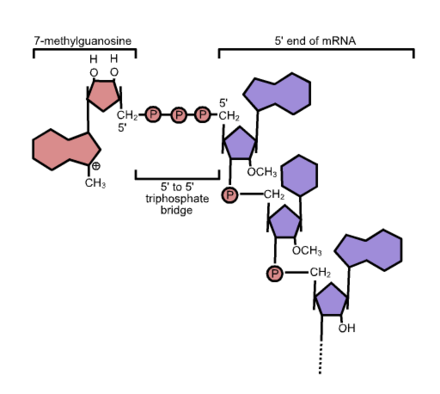
5’_cap_structure
RNA capping in coronaviruses involves activities of several nonstructural proteins (nsps): nsp13, a bifunctional RNA/NTP triphosphatase (TPase) and helicase; nsp14, a bifunctional 3′→5′ mismatch exonuclease, and mRNA cap guanine-N7 methyltransferase; nsp16, a cap ribose 2′-O methyltransferase; and an elusive guanylyl transferase.
In eukaryotes, the 5′ cap (cap-0), found on the 5′ end of an mRNA molecule, consists of a guanine nucleotide connected to mRNA via an unusual 5′ to 5′ triphosphate linkage. This guanosine is methylated on the 7 position directly after capping in vivo by a methyltransferase. It is referred to as a 7-methylguanylate cap, abbreviated m7G.
The five-prime cap (5′ cap) is a specially altered nucleotide on the 5′ end of some primary transcripts such as precursor messenger RNA. This process, known as mRNA capping, is highly regulated and vital in the creation of stable and mature messenger RNA able to undergo translation during protein synthesis. Mitochondrial mRNA are not capped.
RNA capping in CoVs involves activities of several nonstructural proteins (nsps): nsp13, a bifunctional RNA/NTP triphosphatase (TPase) and helicase; nsp14, a bifunctional 3′→5′ mismatch exonuclease, and mRNA cap guanine-N7 methyltransferase; nsp16, a cap ribose 2′-O methyltransferase; and an elusive guanylyl transferase.
Overall structure of the SARS-CoV-2 nsp16/nsp10 ternary complex.

nsp16/nsp10 structure
Binding modes of RNA cap analogues and SAM and mechanism of methyl transfer.
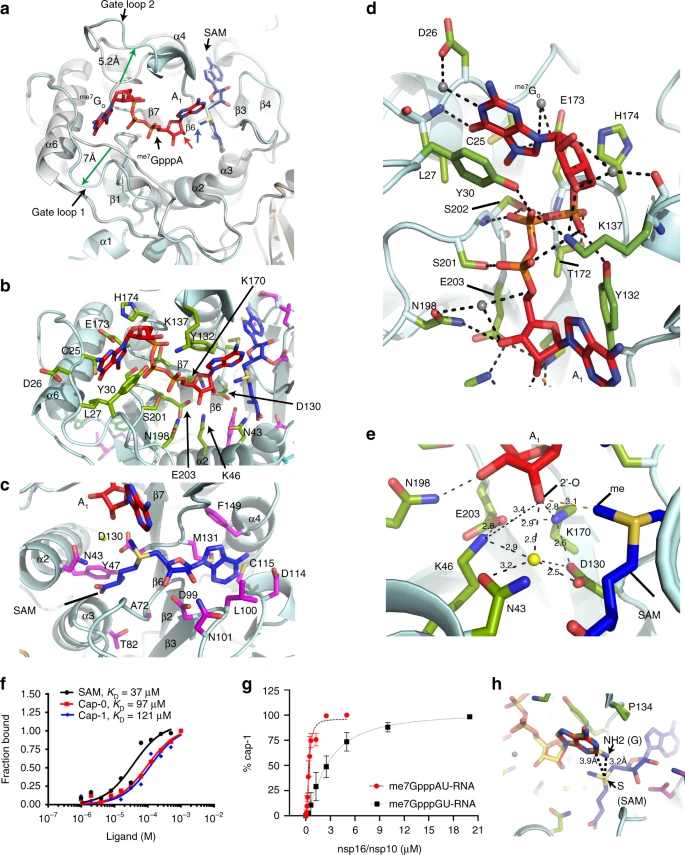
RNA cap analogues binding modes
b green sticks; nsp16 residues that interact with RNA cap.
c magenta sticks; nsp16 residues that contact with SAM.
d A close-up view of Cap-nsp16 interactions reveals a network of hydrogen bonding with successive phosphates, me7GO and A1 nucleotides of cap. Water, gray spheres, h-bonds, black dashed lines.
e A water (yellow sphere) coordinates with the target 2′-O atom of A1, and catalytic tetrad residues and N43. The methyl group of SAM is positioned for direct in-line attack from the 2′-O.
f Binding isotherms and fitting of data for nsp16 binding to RNA cap-0 (me7GpppA), cap-1 (me7GpppAm) analogues, and SAM. Each data point represents average of two independent experiments (n = 2).
g The 2′-O methyltransferase activity measured as percentage of Cap-0 to Cap-1 conversion is plotted against nsp16/nsp10 protein concentration. Higher enzymatic activity is observed on an RNA substrate with A (red circles) as the target base for 2′-O methylation (N1), compared to an identical RNA but with G (black square) as N1 or initiating nucleotide. Results are average of three independent experiments (n = 3) with one standard deviation (s.d.) for each RNA shown as error bars.
h Guanine base (yellow stick) is modeled at N1 position of cognate adenine (red stick). The N2 amine of guanine intrudes into the SAM pocket and may be repelled by positively charged sulfur of SAM (blue stick).
Viswanathan, T., Arya, S., Chan, SH. et al. Structural basis of RNA cap modification by SARS-CoV-2. Nat Commun 11, 3718 (2020). https://doi.org/10.1038/s41467-020-17496-8
How is virus transmissibility measured?
Updated September 3, 2022
Tracking the transmission and evolution of SARS-CoV-2, involves evaluating changes in how well the omicron subvariants evade the immune system and the severity of disease they cause after infection.
The basic reproduction number, R0–pronounced “R-naught”–measures the transmissibility of a virus in a yet-uninfected population.
Once a proportion of individuals in a population become immune due to prior infection or vaccination, epidemiologists use the term effective reproduction number, called Re or Rt, to measure the transmissibility of the virus. The Re of the omicron variant has been estimated to be 2.5 times higher than the delta variant. This increased transmissibility most likely helped omicron to become the dominant variant.
Driving the evolution of omicron sublineages is natural selection, an evolutionary process where traits that give a species a reproductive advantage continue to be passed down to the next generation, while traits that don’t are phased out through competition. As SARS-CoV-2 continues to circulate, natural selection favors mutations that give the virus the greatest survival advantage.
Mechanisms of increased transmissibility
Updated September 3, 2022
Several mechanisms contribute to the increased transmissibility of SARS-CoV-2 variants. The more recent omicron sublineages have mutations that make them better at escaping antibody protection while retaining their ability to effectively bind to ACE2 receptors, a protein in the body that primarily helps regulate blood pressure but can also help SARS-CoV-2 enter cells. The BA.5 sublineage can evade antibodies from both vaccination and prior infection.
BA.2.12.1, BA.4, and BA.5 subvariants substantially escape neutralizing antibodies induced by both vaccination and infection. Moreover, neutralizing antibody titers against the BA.4 or BA.5 subvariant and, to a lesser extent against the BA.2.12.1 subvariant were lower than titers against the BA.1 and BA.2 subvariants, which suggests that the SARS-CoV-2 omicron variant has continued to evolve with increasing neutralization escape. This the immunologic context for the current surges caused by the BA.2.12.1, BA.4, and BA.5 subvariants in populations with high frequencies of vaccination and BA.1 or BA.2 infection.
(N Engl J Med 2022; 387:86-88 DOI: 10.1056/NEJMc2206576)
Omicron sublineages BA.4 and BA.5 share several mutations with earlier omicron sublineages, but also have three unique mutations: L452R, F486V and reversion (or the lack of mutation) of R493Q.
Thorne, L.G., Bouhaddou, M., Reuschl, AK. et al. Evolution of enhanced innate immune evasion by SARS-CoV-2. Nature 602, 487–495 (2022). https://doi.org/10.1038/s41586-021-04352-y
L452R and F486V in the spike protein help BA.5 escape antibodies. In addition, the L452R mutation helps the virus bind more effectively to the membrane of its host cell, a crucial feature associated with COVID-19 disease severity.
BA.5 appears to compensate for decreased ACE2 binding strength through another mutation, R493Q reversion, that is thought to restore its lost affinity for ACE2. The ability to successfully escape immunity while maintaining its ability to bind to ACE2 may have potentially contributed to the rapid global spread of BA.5.
In addition to these immune-evading mutations, SARS-CoV-2 has been evolving to enhance immune evasion. Innate immunity is the body’s first line of defense against invading pathogens, comprised of antiviral proteins that help fight viruses. SARS-CoV-2 has the ability to suppress the activation of some of these key antiviral proteins, meaning it’s able to effectively get past many of the body’s defenses. This explains the spread of infections among vaccinated or previously infected people.
Innate immunity exerts a strong selective pressure on SARS-CoV-2. Delta and omicron, the two most recent and highly successful SARS-CoV-2 variants, share several mutations that could be key in helping the virus breach innate immunity.
Wang, Q., Guo, Y., Iketani, S. et al. Antibody evasion by SARS-CoV-2 Omicron subvariants BA.2.12.1, BA.4 and BA.5. Nature 608, 603–608 (2022). https://doi.org/10.1038/s41586-022-05053-w;
After BA.5…
Updated September 3, 2022
BA.5 will not be the end. As the virus continues to circulate, this evolutionary trend will likely lead to the emergence of more transmissible variants that are capable of immune escape.
While it is difficult to predict what variants will arrive next, some of these variants could lead to increased disease severity and higher hospitalization rates. As the virus continues to evolve, most people will get COVID-19 multiple times despite vaccination status. Therefore, it is essential to recognize that vaccines protect you from severe disease and death, not necessarily from getting infected.
Because the virus constantly evolves, updating vaccines to match circulating variants may not be practical in the short term because the virus evolves too quickly. Vaccines that generate antibodies against a broad range of SARS-CoV-2 variants and a cocktail of broad-ranging treatments, including monoclonal antibodies and antiviral drugs, will be critical in the fight against COVID-19.
Adapted from https://theconversation.com/how-the-omicron-subvariant-ba-5-became-a-master-of-disguise-and-what-it-means-for-the-current-covid-19-surge.
